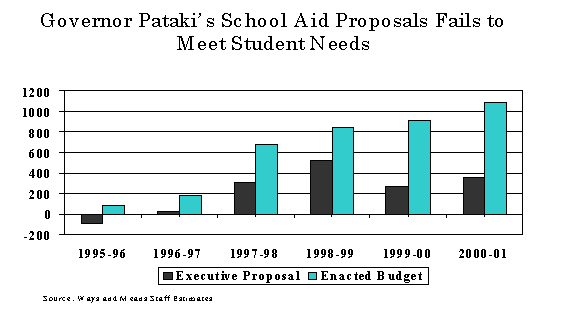
Figure 1
At the dawn of the 21st Century, we face many critical challenges to sustaining our prosperity and our democracy. None, however, is more essential than ensuring our children get the best educational foundation we can provide for a productive lifetime of learning, achievement, and citizenship. Without question, an essential ingredient to our national well-being and New York's economic future must be strengthening the educational tools available to every New York child, as early in life as possible.
There is too much at stake to allow any of New York's children to fall through the cracks of our educational system. Our schools must not only meet, but exceed, their highest expectations by furnishing every child with the skills he or she needs to reach their potential. To achieve this goal, we must endeavor to provide every student with a classroom that fosters learning, a classroom that challenges, inspires, and draws out their best talents.
Four years ago, we embarked upon a mission to make New York State's public education system the strongest in the nation. To this end, the Assembly created the Learning Achieving Developing by Directing Education Resources (LADDER) program: a comprehensive, multi-year education initiative to secure a brighter future for all of our children. The LADDER program targets significant educational and financial support for children throughout the State by reducing class size, repairing and constructing school buildings, providing incentives for full day kindergarten, strengthening professional development, providing resources for up-to-date instructional materials and educational technology and establishing a Universal Pre-kindergarten program; these programs are all geared to provide children with a firm foundation upon which to base their continued achievements.
The Executive proposal for the 2001-02 once again turns its back on our children and our schools. As the schools strive to increase the achievement of their students, meet the new Regents higher learning standards, and improve their school environment, resources become essential. The Executive proposal represents a $1.129 billion cut in total State support for education that would have been generated under current law (see Figure 1). The budget provides $382 million or 2.79 percent more than last year in General Support for Public Schools; this represents a $1.078 billion cut in General Support for Public Schools that school districts would have received under present law provisions. The remainder of the total cut of $1.129 billion is from the Executive's elimination of $51.3 million in grants that are outside General Support for Public Schools (see Table 1). The amounts of these cuts are calculated on a school year basis.

Table 1
MAJOR EDUCATION CUTS
($ in millions)
|
Present Law
|
Executive
|
Difference
|
|
| Flex Aid Components |
$9,975.2
|
$9,828.5
|
(146.7)
|
| Building Aid |
1,659.1
|
1,345.2
|
(313.9)
|
| BOCES |
482.7
|
455.3
|
(27.4)
|
|
LADDER: |
|
225 140 0 15 0 258.5 30.2 0 |
(660)
(275) (85) (80) (76) (25) (84.2) (25) (10) |
| TEACHERS: Teacher Support Aid Mentor Teacher Intern Professional Development Grants Teacher Centers National Board |
67.48 5 10 30 1 |
15 0 0 0 0 |
(98.48)
(52.48) (5) (10) (30) (1) |
| Bilingual Education |
11.2
|
0
|
(11.2)
|
| Small Cities Aid |
81.88
|
69.31
|
(12.57)
|
Continuing the Assembly LADDER Program
The 2000-2001 school year marked the third year of implementation for the Assembly's four-year phase in of the LADDER program that is primarily designed to improve the quality of early childhood education. This innovative initiative provides a comprehensive approach to improving the educational system of the State which will culminate in an additional $1.3 billion in State support for education by 2001-02.
Certainly, the flagship initiative of LADDER is the Universal Pre-kindergarten program. Many questioned the feasibility of attempting to provide Pre-kindergarten services to all four-year olds in New York State in just four short years. But the Universal Pre-kindergarten program has defied the odds. In 2000-01, there were 52,000 four year olds served by the Universal Pre-kindergarten program; this represents 88 percent of the eligible children to be served in the program. The $201 million in obligated funding represents 89 percent of the total available funds for the third year of the program. In fact, a front-page article in the October 25th issue of Education Week confirms this by stating:
| "With the idea of universal preschool slowly gaining more attention in the United States, one state (New York) has shown in a relatively short amount of time how to bring the public school system and providers of early-childhood education together to give more four-year olds educational opportunities." |
Full funding of $500 million for Universal Pre-kindergarten programs throughout the state will establish New York as the national leader in providing pre-kindergarten programs (see Figure 2) and ensure that all the children of New York State are well prepared for a 21st Century education.
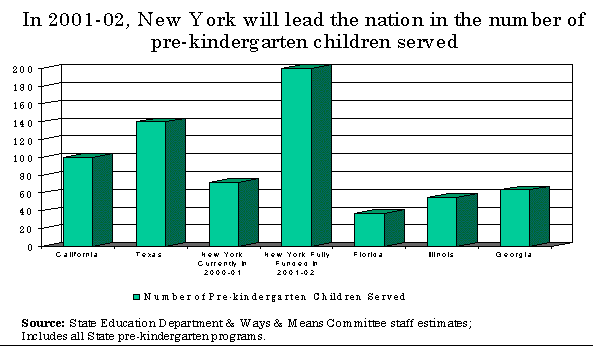
Overall, LADDER's strong early education focus includes the Universal Pre-kindergarten program, reducing class sizes to twenty for grades K-3, and providing resources to move schools to full-day kindergarten programs. Research has consistently documented the benefits of pre-kindergarten and lower class size including increased achievement, higher graduation rates, lower dropout rates and reduction of disruptive behavior. These efforts have already proven enormously successful; during the 2000-01 school year roughly 52,000 four-year olds are enrolled in Universal Pre-kindergarten programs, approximately 1,100 new classrooms have been funded through the Class Size Reduction Program, and more than 14,000 additional kindergartners have been enrolled in full day-kindergarten programs as a result of the LADDER program (see Figure 3).
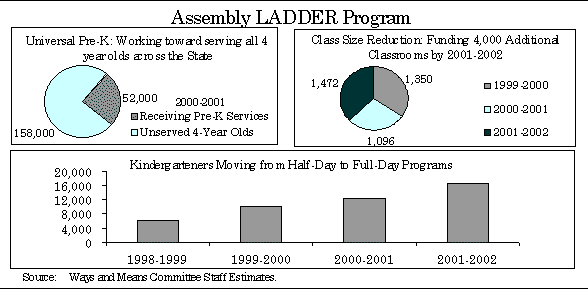
School Facilities
Another component of the LADDER plan is its efforts to improve the condition of school facilities across the state through formula changes which increase State support for construction. By successfully enacting a 10 percent increase in Building Aid reimbursement, a regional cost factor and by providing additional aid for minor maintenance and repair projects, the Assembly has taken the lead in directing the resources necessary to restore the condition of school facilities to a level which begins to support the hopes and dreams of the students of New York. The December 6, 2000 issue of Education Week reinforces this bold claim by stating; "Today, researchers appear to have reached considerable agreement on the question of whether the quality of school facilities boost student achievement. Most scholars who have studied the question concur, for example, that achievement suffers in rotten school environments."
The Assembly has continued to push for additional funds for school construction and this resulted in the enactment of the Assembly RESCUE plan. In School Year 1999-2000, RESCUE provided an additional $145 million in State support for critical school facility needs. This valuable program was expanded by $50 million in School Year 2000-01. Districts can apply for funding for critical capital projects and will be allowed to use these funds to offset the costs of improving the condition of school facilities.
Beyond simply providing additional resources for school facilities, RESCUE also includes the establishment of a comprehensive public school building safety program which requires the annual inspection, safety rating and monitoring system of all public school buildings used primarily for instruction. This serves as a mechanism to ensure that facilities are well maintained and well equipped to support the efforts of students as they prepare for the future.
However, even with the recent efforts of the Legislature to provide additional State support for school facilities, there remains an unmet need for capital expenditures. In addition, the new learning standards set by the Regents will require facility changes to correlate with instructional changes, including the need for modern science laboratories and air conditioned buildings so that additional summer instruction can occur. With many of the 4,000 school buildings in New York State being built prior to World War II, it is essential that the State continue to provide the resources necessary to improve the condition that students face in their school facilities on a daily basis.
An additional piece of the LADDER plan has been the directing of much needed resources for computer and technology needs, textbooks and computer software, staff development and extended day-school violence prevention programs.
The 2001-02 school year marks the final year of the four-year statutory phase-in of the Assembly LADDER plan. With this, the success of the efforts of the previous three years will be built upon through the continued expansion of the programs included within the LADDER plan. Present law provisions require an appropriation of $500 million in funding for Universal Pre-kindergarten, which will allow four-year olds the opportunity to attend pre-kindergarten programs; $225 million in funding for early grade class size reduction, which will provide for an estimated 1,500 additional classrooms; continued enhancements to building aid; an appropriation of $91 million for educational technology; funding of $35 million for professional development; an additional $50 million in funding for textbooks and software materials; and $50.2 million for extended day-school violence prevention programs. The Assembly remains committed to providing the full level of funding for LADDER programs as agreed to by the Governor and both houses of the Legislature during the 1997-98 State Budget negotiations. The cumulative effect of all of these LADDER initiatives work to support the attainment of the new Regents higher learning standards for all students. We will not accept the Governor's attempt to renege on these commitments.
The Challenge of Higher Standards
Following the lead of the Board of Regents, New York State has taken many steps to raise educational standards. New curriculum standards, high stakes examinations, and tougher graduation requirements are now demanding a lot more of our students, teachers, parents, and schools. But raising standards doesn't come without hard work and investment. We must ensure that all of our schoolchildren receive the support they need to meet the new standards.
There is no doubt that the standards movement in New York has made an impact. More students are taking and passing Regents examinations; the percentage of students passing has increased on all of these examinations. In fact, more students received a passing score on the Regents English examination in 1998-99 than had taken this examination in 1996-97. In addition, the percentage of graduates earning Regents diplomas has increased from 35 percent in 1989 to 45 percent in 1999.
But our work is just beginning. In the lower grades, especially the middle years, our children continue to perform at levels below their potential. On the 1999-2000 8th grade mathematics assessment, only 40 percent of eighth-graders met or exceeded the standards. On the 1999-2000 8th grade English and language arts assessment, only 45 percent met or exceeded the standards (see Figure 4). These numbers are impossible to ignore. New and more rigorous statewide tests are demonstrating a gap between current achievement levels and what is required under the new standards.
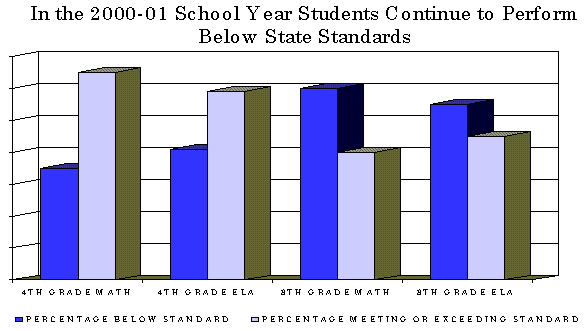
The Assembly will continue to fight for additional unrestricted aid for the support of raised academic standards. Recent increases in unrestricted aids such as Operating Aid, Extraordinary Needs Aid and Operating Standards Aid have given local districts the flexibility to target resources toward their particular needs. In fact, in 2000-01, total funding for unrestricted aids were the largest share of formula aids provided to school districts. The Assembly remains committed to providing adequate resources to support the educational needs of all children throughout New York State.
Recruiting and Retaining Quality Teachers
The issue of the quality of teaching has taken center stage in education discussions throughout the country. A growing body of evidence confirms what common sense has suggested all along: good teaching is a determining factor in how well students learn.
In our struggle to raise standards and improve student learning, there is little doubt that a focus on teacher quality must be central to any reform effort. However, New York State will be facing serious teacher shortages in the near future. In fact, 38 percent of New York's current teachers will retire or reach age 55 years and be eligible for full retirement benefits within the next five years. The baby-boom generation of teachers is reaching retirement age and the children of baby boomers are working their way through the school system, creating the need for additional teachers.
In addition to the supply problem, many recent policy changes such as those to raise learning standards, end social promotion, and reduce class size, increase the demand for additional high quality teachers. The problem of low supply and high demand for teachers exacerbates an already difficult teaching situation in urban schools where the teaching environment has been harsh for a long period of time. High teacher turnover and low median teacher salaries are apparent in these high need districts (see Figure 5).
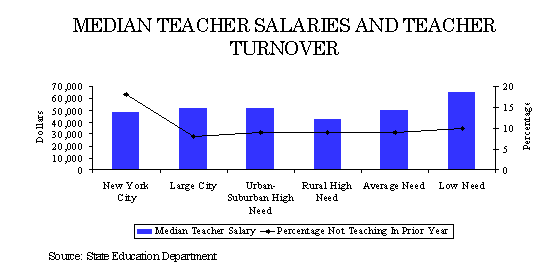
To combat these shortages that loom on the horizon, we must increase State support for teacher programs. While the Executive proposal increases funding for the Teachers of Tomorrow program, it is bewildering that the Executive has once again attempted to cut by more than $98 million, existing recruitment, retention and education programs, including a significant reduction in Teacher Support Aid, and the elimination of Teacher Centers, the Teacher-Mentor-Intern Program, the National Standards Board Program and Instructional Staff Development. All these programs seek to establish a better trained professional workforce; elimination of these resources is simply shortsighted.
Without a vibrant, intelligent and motivated teaching force, we cannot create the educational system our children need. Therefore, the Assembly will continue to fight for State support for teacher recruitment, professional development and retention efforts.
Executive Budget Fails to Provide Leadership in Education
The Executive Budget for the 2001-02 school year leaves school districts without the resources they need to help their students meet the challenges of the future. The Executive proposes a decrease in State support for education of $1.129 billion when compared to present law. This is the result of cuts to General Support for Public Schools, the Assembly LADDER program, building aid and other educational programs as well.
Executive "Flex Aid" Proposal
The cornerstone of the Governor's proposal is the consolidation of 11 school aid categories into a single category -- Flex Aid. While this new aid category is increased by $250 million in the Executive proposal, this amount is $147 million less than the amount called for by current law for the consolidated aids (Operating Aid, Tax Equalization Aid, Tax Effort Aid, Limited English Proficiency, Gifted and Talented, Extraordinary Needs Aid, Educationally Related Support Services Aid, Public and Private Excess Cost Aid, Operating Standards Aid, and Minor Maintenance Aid). Nearly 70 percent of the Flex Aid increase of $250 million will be targeted to high-needs school districts including New York City; however the amount of the total increase is clearly insufficient.
Executive Building Aid Proposal
Beyond cuts in Flex Aid and LADDER, the Governor further reduces School Aid through other programs. One of the largest reductions is in the Building Aid category which prescribes a $314 million cut to present law. The Executive proposes numerous changes to Building Aid that drive this reduction including: priority-based selection and regional allocations, an assumed amortization schedule, ineligibility for aid for buildings that are not maintained, and aid ratios tied to when the project is approved. Considering the present conditions of school buildings in New York State, any reform to the Building Aid methodology will have to undergo strict evaluation to assure that school districts continue to have the resources necessary to tackle critical capital projects and ensure safe school facilities.
Localities have consistently been forced to shoulder an increasing burden of educational spending. The Education Department estimates the current level of State support to be 41.7 percent. In fact, a ranking of states by state support for education shows a decline from last year; New York State ranks well below the halfway mark, at 40th. (National Educational Association, Ranking of the States 2000) (see Figure 6)
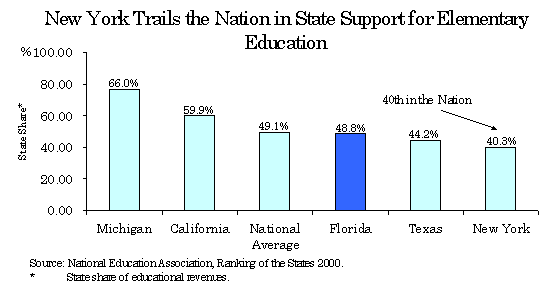
We must provide every New York child equal access to every educational possibility, from early childhood to graduation. That means providing the time-proven benefits of pre-kindergarten and full-day kindergarten; reducing class size not only in grades K-3, but throughout all grades as well; building upon the Board of Regents ongoing efforts to raise standards by providing additional support for academic intervention services; and making certain that our school buildings are safe, modern, and technologically equipped.
School Aid Litigation
Litigation was commenced in May of 1993 in State Supreme Court challenging New York State's funding structure for New York City public schools. The lawsuit was filed on the grounds that the current system violated the Education Clause of the New York State Constitution, the Equal Protection Clause of the State and Federal Constitutions, and Title VI of the Civil Rights Act of 1964 and its implementing regulations.
On January 10, 2001, the Court rules in favor of the plaintiff on both the State Constitutional claim and the claim involving the implementing regulations of Title VI of the Civil Rights Act. The Court held that New York State has consistently violated the Education Article of the State Constitution by failing to provide the opportunity for a sound basic education to New York City's public school students. In addition, the Court found that the school financing system has an adverse unjustified disparate impact on minority public school students in violation of Federal Civil Rights regulations.
Although the Court did not prescribe a specific remedy, it stated that it is the responsibility of the State Legislature to take the necessary steps to reform the education system by September 15, 2001. The Governor has announced his decision to have the State appeal the Court ruling.
The 2001-02 Executive budget proposal continues to ignore the need to reinvest in Higher Education. Leaders from across the nation have embraced the concept that investing in a strong higher education system provides a crucial foundation for economic growth and the development of a highly trained workforce. Yet, while the nation was experiencing its greatest economic expansion in history the Executive proposed cumulative reductions in support of higher education totalling approximately $1.6 billion. The Assembly has stood firm in its commitment to working families from across the state and has fought to restore roughly $1.4 billion of these proposed reductions. Fighting against proposed reductions has limited the States ability to focus on expanding and improving existing programs. This year, the Assembly will continue to fight for working families and students seeking to expand their horizons through the pursuit of a higher education.
SUNY and CUNY
The Governor's proposal would provide a total of $1.8 billion in General Fund support for the four-year colleges of the State's two public university systems. This includes $1.2 billion in support of the general operating budget of the State-operated campuses of the State University of New York (SUNY) and $612 million in General Fund support for City University of New York (CUNY) senior colleges. Unfortunately, tuition and fee expenses have increased significantly in recent years at the two public university systems of the state.
The Governor's proposal also provides 324.6 million for SUNY operated community colleges and $128.6 million for CUNY community colleges. This reflects the continuation of the $125 per full time equivalent student base aid increase which was enacted in 2000-01. Unfortunately, the Governor fails to provide funding for other important improvements that were made in 2000-01 such as providing support for additional faculty and childcare services, and improved opportunities for economically disadvantaged students.
Tuition Assistance Program
The Governor also provides $636.4 million for the Tuition Assistance Program (TAP). This represents no change in state support for the program since 2000-01 resulting from improvements in the economy and income growth, which lowers average award levels. The Governor continues the enhancement to the program enacted in 2000-01 rather than make improvements to the program. The TAP program has been the target of proposed reductions throughout the term of Governor Pataki. This program is one of the most significant investments that New York State provides to students seeking access to a higher education. As the cost of receiving a higher education has steadily risen, the need for additional tuition assistance has never been more imperative.
SUNY Hospitals
The Executive proposal also includes a plan to restructure the fiscal relationship between the SUNY Health Science Centers (HSCs) and the State of New York. All hospital spending will be appropriated into a single account and the hospitals will be responsible for directly paying their fringe benefit and debt service costs. The Governor provides the HSCs with a direct state subsidy of $92 million to support their operations. This includes $40.7 million to reflect the continuation of the State's current subsidy level for the cost of fringe benefits. An additional $51.4 million is proposed in recognition of costs to the HSC's for State agency operations. In addition to proposing to change the fiscal relationship between the HSCs and the State, the Executive proposes to address the current $209 million shortfall in the SUNY operating budget that results from the HSC's inability to meet the $116 million assessment for the last two years. The Executive recommends a multi-year plan and authorizes the transfer of $15.2 million from available revenues of the Dormitory Authority of the State of New York as the State's initial payment to provide $84.6 million in State support. In addition, the Executive proposes HSCs contribute the remaining $124.4 million over a multi-year period. The State Financial Plan for 2001-02 assumes a payment of $11.2 million in 2001-02 as the HSCs efforts toward eliminating the shortfall.
Throughout the past six years, New York State has trailed the rest of the nation
in support for higher education (see Figure 7). In fact, over the last five-years
the cumulative increase in state appropriations for higher education has been
four percent, which ranks New York State 38th in the nation. (Chronicle of Higher
Education). In 1995, the average cost of tuition and fees for students attending
public four-year institutions in New York State was approximately $2,971. Since
1995 the average cost of tuition and fees has increase by approximately $934
or 31.44 percent to $3,905 (1995-96 and 2000-01 Almanac of Higher Education).
As a result, the average cost of tuition and fees for a student attending a
public four-year institution in New York State is roughly 17 percent greater
than the national average (2000-01 Almanac of Higher Education).
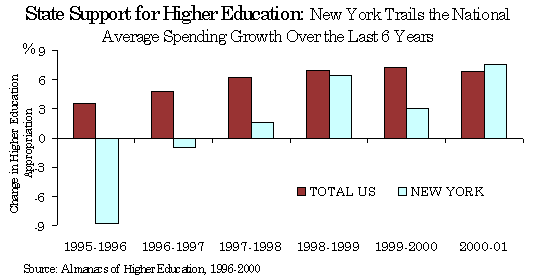
In 1999-2000, tuition and fee costs for attending a community college in New York State were over 56 percent higher than the national average. In a time when a significant investment is being directed toward large research institutions, the needs of the state's community colleges should not be ignored. Community colleges serve as a gateway to the pursuit of a higher education and train a significant portion of the workers needed in the new economy.
In order to reduce the burden on working families with students pursuing a college degree, the Assembly fought for historic increases to the Tuition Assistance Program (TAP) as part the 2000-01 enacted budget. As a result, the TAP Program increased by $21.4 million in 2000-01, marking the first year of a four-year phase-in of enhancements that will increase expenditures for the TAP program by $94 million by 2004-05. Included within this plan are the following provisions: increasing the maximum TAP award to $5,000 over a four year period beginning in 2000-01; raising the limitation on TAP awards to 95 percent of tuition expenses in the 2000-2001 and fully phasing out the award limitation in 2001-02. In addition, college juniors and seniors have received an additional increase of $50 in their TAP awards in the 2000-2001 academic year, and in 2001-02 juniors and seniors will receive an additional $100 increase in their TAP awards. Finally, the 2000-01 academic year began a three-year phase-in of an expansion of the minimum TAP award, this will increase the TAP award to $500 and raise income eligibility to $80,000.
In addition to expanding the TAP Program, a college tuition tax reduction was enacted which will provide $200 million in tax relief annually when fully implemented. Here, working families with a student pursuing a higher education will have the choice of deducting from their income 100 percent of qualified tuition expenses up to $10,000 or receiving a tax credit of the lesser of $200 or tuition paid. Finally, the Assembly fought for the restoration of support for opportunity programs for economically disadvantaged students at funding levels last achieved in 1994-95 and also additional support for additional faculty and childcare services at the State's public university systems. The Executive fails to maintain the Legislature's support for these programs.
The Assembly is committed to reinvesting in higher education and will continue
to fight to ensure that appropriate resources are provided to encourage economic
growth, ensure a quality education, and maintain access to a higher education
for New York's working families.
Medicaid
The Governor's State Fiscal Year 2001-02 cost containment package will result in the loss of more than $350 million in combined Federal, State, and local reimbursement to certain Medicaid providers. These new cuts are targeted primarily at nursing homes, but also impact certified home health care agencies and the pharmaceutical industry. These actions are certain to have a devastating impact on the quality of health care that is delivered by the State's long-term care facilities that are already struggling with pressing workforce issues and losses from previously enacted cuts. Approximately 15 percent of New Yorkers age 65 and older rely on Medicaid to cover their health care expenditures. As the elderly use a disproportionate share of nursing home and home health care services, New York's seniors are most at risk from these cuts. (see Figure 8)
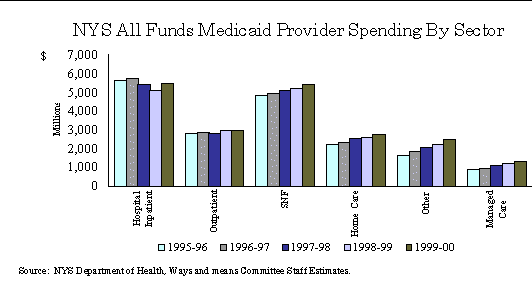
The Health Care Reform Act of 2000: An Update
The enactment of the Health Care Reform Act of 2000 (HCRA 2000) created a number of new programs designed to provide health insurance coverage to many uninsured and underinsured New Yorkers.
HCRA 2000 established Family Health Plus (FHP), a comprehensive plan for subsidizing health insurance that will provide needed coverage for many of the uninsured parents of children now enrolled in the Child Health Plus (CHP) program. Although FHP was originally scheduled to begin on January 1, 2001, implementation is dependent on the State receiving necessary approvals from the Federal government. The Department of Health is moving forward in that process. Once the requisite Federal approvals are obtained from the Health Care Financing Administration (HCFA) the State will launch an advertising campaign to let people know that the program is beginning.
In addition, the HCRA 2000 created "Healthy New York," subsidized insurance for small businesses with 50 employees or less so they can provide their workers with basic health insurance. HCRA 2000 also subsidized premiums for workers whose employers do not provide insurance and those who are self-employed. Insurers will begin offering coverage for both programs on January 1, 2001. In total, the health insurance programs created in HCRA 2000 are expected to provide health insurance coverage for approximately one million New Yorkers.
Child Health Plus
In 1990, the Legislature established Child Health Plus (CHP), a program that provides health insurance to underinsured and uninsured children in New York State. In 1998, the Legislature expanded the Child Health Plus (CHP) program, greatly increasing the number of children eligible for health coverage in New York State. Additionally, the CHP expansion increased the number of services covered under the program; provided free coverage for children in families with incomes less than 160 percent of the Federal Poverty Level; lowered monthly premium contributions; eliminated family co-payments, and authorized the development of public education, outreach, and facilitated enrollment strategies. The legislation also raised the income eligibility levels for children receiving health care coverage under the Medicaid program.
Although New York State's Child Health Plus (CHP) program is one of the best in the nation, many children still face obstacles to enrollment and to retention of coverage. Moreover, the United Hospital Fund recently reported that more than 650,000 uninsured children appear to be eligible for either CHP or Medicaid, but are not enrolled in either program. The Child Health Plus program is due to expire on March 31, 2001. The Governor's budget proposal includes a simple extension of the current program until June 30, 2003. While continuation of this worthy program is assured, the Legislature will use this opportunity to address these and other concerns raised by the current program.
Managed Care
In his first budget six years ago, Governor Pataki proposed a plan to cut Medicaid costs while improving access to medical care for Medicaid recipients by enrolling such recipients, including the disabled, in managed care plans. His waiver application to the Federal government, entitled "The Partnership Plan," stated that by April 1997, 2.2 million Medicaid recipients would be enrolled in managed care. Nevertheless, even with Federal approval of mandatory Medicaid managed care in July 1997, enrollment has remained relatively flat. For the past few years, Medicaid managed care enrollees have hovered between 30 to 31 percent of eligible participants. In May 1999, New York State received Federal approval to begin mandatory enrollment of 1.5 million New York City Medicaid residents into managed care plans. The impact of this approval has yet to affect Medicaid managed care enrollment, which still constitutes 31 percent of total eligibles. As of November 1, 2000, Medicaid managed care enrollment was at 679,241 enrollees, up only four percent from November 1999. (see Figure 9)
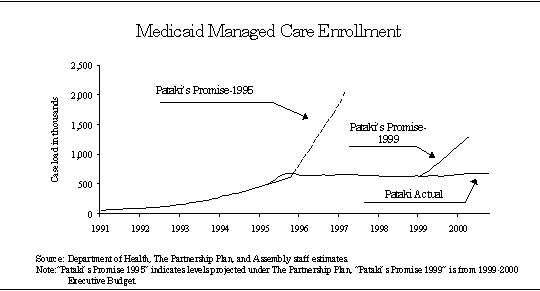
Despite this lack of progress, the Executive continues to be optimistic about Medicaid managed care. His Executive Budget promises that by the end of SFY 2000-01, enrollments will rise to 796,000 and that 1.1 million Medicaid recipients will be enrolled in managed care by the end of SFY 2001-02.
Work and Wellness Act of 2000
Many persons with disabilities want to work but cannot take decent paying jobs without losing Medicaid coverage. Existing Medicaid income and resource limits prevent disabled individuals from earning enough to support themselves or their families. Persons with disabilities who are capable of working keep their earnings low in order to retain the Medicaid coverage they need to survive. The Federal Ticket to Work Incentives Improvement Act of 1999 provided states with the opportunity to implement Medicaid Buy-In programs with Federal Financial Participation (FFP).
In June 2000, the Assembly acted on the Federal statute and passed the Work and Wellness Act of 2000. However, the Senate and the Executive failed to take action.
Under the proposal passed by the Assembly in 2000, working individuals with disabilities would buy into the Medicaid program by paying premiums on a sliding fee scale based on income. Eligible individuals would include severely disabled workers with net available incomes up to 400 percent of the Federal Poverty Level, as well as workers with a severe impairment who cease to receive Supplemental Security Income (SSI) or Supplemental Security Disability Income (SSDI) benefits due to the improvement of their medical condition. The fiscal implications would not be significant, because many individuals who would participate are already in the Medicaid program. Moreover, the Assembly bill provided that the State would pay the entire non-federal share for program participants so there would be no new cost for local governments associated with the program. Additionally, the State would benefit from new State tax revenues and premiums paid by program participants.
The Governor's 2001-02 Executive budget recognizes the worthiness of the Medicaid Buy-In for the working disabled and recommends passage of a program. The Governor's proposal would provide eligibility to disabled working individuals whose income is up to 250 percent of the Federal Poverty Level (FPL), versus the 400 percent of FPL eligibility level proposed by the Assembly, effective January 1, 2002.
AIDS
AIDS is the fifth leading cause of death among Americans, aged 25 to 44, and the ninth leading cause of death among Americans, aged 15 to 24. In New York State, there are over 50,000 people living with AIDS and approximately 170,000 others living with symptomatic and asymptomatic HIV infection. At the same time, the rate of infection continues to grow, particularly among minorities, youth and women. Moreover, in recent years, there has been much medical advancement for individuals living with HIV/AIDS, in particular, the development of new drug therapies. While such advancements are helping these individuals live healthier, longer lives, they are also creating a greater demand for services.
Community-based organizations provide a wide variety of services to persons living with HIV/AIDS, including counseling, case management, legal counsel, medical respite, and home-delivered meals. Community-based services also provide programs that help HIV families plan for the future care of their children and offer support to children and adolescents who lose a parent or sibling to HIV. These programs have become a central component in New York's fight against HIV/AIDS.
Despite the escalating need for services, the Executive again this year fails to recommend increased funding for AIDS programs. In fact, the Executive proposes to eliminate over $7 million in legislative enhancements that were included in the SFY 2000-01 enacted budget.
In previous years and again this year, the New York State AIDS Advisory Council
recommends that funding be restored for a variety of programs that are not included
in the Governor's proposed budget for SFY 2001-02. The Council also recommends
additional funding for AIDS-related programs to increase education, outreach
and support services.
Currently, approximately three million persons who are 60 years of age or older reside in New York State. This number is expected to increase dramatically in future years as the "baby-boom" population, which comprises 24 percent of the State's total population, reaches 60 years of age.
Despite this growing population, the Executive fails to recommend substantive increases to senior programs. In fact, the Executive proposes to eliminate approximately $6 million in legislative initiatives and enhancements that were included in the SFY 2000-01 enacted budget.
Community-based services for the elderly help older New Yorkers to be as independent as possible, for as long as possible, thereby avoiding costly institutional care. In a recent report published by the State Office for the Aging (SOFA), entitled Project 2015: The Future of Aging in New York State, findings indicate that as the "baby-boom" population reaches 65 years, "good nutrition will play a significant role in affecting chronic health conditions and illness." The report also indicates that practicing healthy nutrition habits now would decrease the likelihood of utilizing more costly services in the future, like long-term institutional care. In order to guarantee good health among our aging population, the report recommends taking steps to "ensure that people in the greatest need are identified and served and to improve outreach and expand programs to reach more older people who are food insecure and homebound." Despite these suggestions from the Governor's State Office for the Aging, the Governor fails to recommend increased funding for community-based services, like the Supplemental Nutrition Assistance Program (SNAP) and the Expanded In-Home Services for the Elderly Program (EISEP), which provide such services.
Elderly Pharmaceutical Insurance Coverage (EPIC) program
In the enacted State Fiscal Year (SFY) 2000-01 budget, the Legislature significantly enhanced the Elderly Pharmaceutical Insurance Coverage (EPIC) program. The EPIC expansion, which became effective January 1, 2001, increased income eligibility to $35,000 for singles and $50,000 for married couples. In addition, the EPIC expansion reduced annual fees and co-payments by 20 percent and reduced co-pay thresholds by five percent. The EPIC expansion also reduced the number of co-payments from five to four. Additionally, the EPIC expansion simplified the program structure by limiting the fee plan to incomes up to $20,000 for singles and $26,000 for married couples and by providing that eligible persons with incomes over these amounts will be in the deductible plan.
Currently, approximately 130,000 seniors are enrolled in the EPIC program. The Executive anticipates the EPIC expansion will increase enrollment to over 215,000 seniors by the year 2003. (see Figure 10)
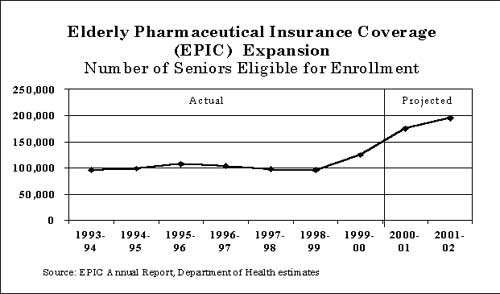 Figure 10
Figure 10The Executive's forecast for the national economy is generally in line with those of other forecasters. The Executive estimates that economic growth for 2000, as measured by growth in real gross domestic product (GDP), will reach 5.1 percent. For 2001, the Executive projects a slower growth rate of 2.7 percent. This forecast for 2001 is just 0.1 percentage points above the Blue Chip Economic Consensus, which is a compendium of the forecasts of 50 private sector forecasters.
The Executive is forecasting a decrease in the rate of consumer price inflation from 3.3 percent in 2000 to 2.7 percent in 2001. This is primarily due to the unwinding of most of the increase in the core inflation rate experienced in 2000 which had increased the prices of energy and energy-related products. National employment growth is expected to slow to 1.1 percent in 2001 from 2.1 percent in 2000. Growth in both personal income and its largest component, wages and salaries, is projected by the Executive to decline from 6.3 percent and 6.5 percent, respectively, to 5.0 percent and 5.5 percent in 2001. U.S. corporate profit growth is projected to decline from 14.2 percent in 2000 to 3.4 percent in 2001.
The Executive projects a slowdown in State employment growth for 2001 from 2.1 percent for 2000 to 1.4 percent for 2001. Growth in the non-bonus component of wages and salaries is also expected to decline from 7.7 percent in 2000 to 5.4 percent in 2001. However, growth in the bonus component of wages is expected to drop from 19.4 percent in 2000 to 2.4 percent in 2001. Combining these two components produces growth in overall State wages and salaries of 9.1 percent in 2000, followed by lower growth of 5.0 percent for 2001. Similarly, overall personal income growth will drop from 7.8 percent in 2000 to 4.6 percent in 2001.
The Executive states the New York economy has strengthened relative not only to its own recent performance, but also to the rest of the nation. However, although New York State employment growth outpaced U.S. employment growth in 1999, State employment has grown at only about two-thirds of the national rate since 1995. Indeed, had New York kept pace with the nation since 1995, the State would now have an additional 384,200 jobs, for a total of over one million new jobs (see Figure 11). Had New York grown as fast as Florida, Texas, or California, we would have generated much more than one million new jobs (roughly 1.8 million, 1.7 million, and 1.5 million, respectively).
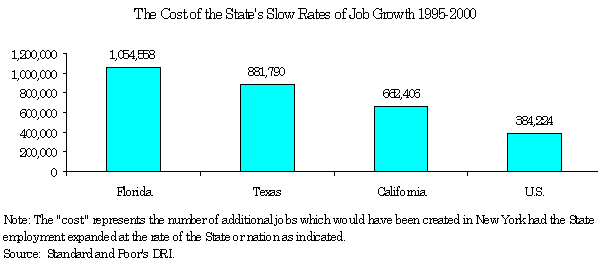
Even now, New York is doing better than 30 other states of the union (see Table 2). On the basis of total employment growth for 2000, New York ranks 19th among the 50 states and the District of Columbia. In contrast to New York, all of the nation's other large states rank among the top ten. Florida's 4.2 percent rate of growth makes it the third fastest growing state in the nation. California ranks sixth at 3.2 percent, while Texas ranks eighth at 2.7 percent.
However, employment growth within the State is uneven. For example, if Downstate were a separate State, it would have ranked 15th in the employment growth while Upstate would have ranked only 33rd. Downstate ranks in the top third, while Upstate ranks in the bottom third.
While the economy may appear to some to be much stronger than it was in the 1980s, it is not obvious in all areas of the state. For example, in Western New York, the 1980s economic expansion employment growth was much stronger than it has been in the current expansion that started in the 1990s. Furthermore, the gap in employment growth between Western New York and the nation has widened.
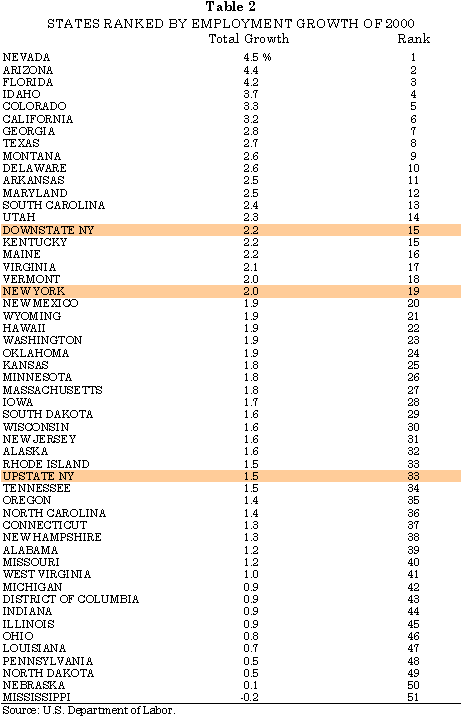
Clearly, the Executive's economic development policies have failed to capitalize on the longest economic expansion in history. Upstate manufacturing employment has fallen consistently since July 1998 following a short period of growth immediately prior. Upstate employment growth of 1.2 percent fell a full percentage point below the downstate growth of 2.2 percent in the first half of 2000.
The lag in upstate growth is further illustrated when looking at regional employment growth. The Western New York region saw virtually no growth in 1998 and recent employment data suggests that while the upstate economy shows signs of improvement, it continues to lag behind downstate and statewide figures. Employment in the Western New York region, which includes Erie and Niagara Counties, grew by only .4 percent in the first half of 2000 compared to 1.2 percent for upstate, and 2.0 percent statewide. If Western New York data is excluded, the upstate region shows growth of only 1.3 percent during the half of 2000. The Finger Lakes region, including Monroe County, experienced a growth rate of only 1.4 percent and the Central New York region, including Onondaga County, saw a growth rate of only 1.6 percent. Both trailed the remaining upstate regions and lagged behind the state average in employment growth.
While employment growth in New York City has been strong the last several years; the rate of growth has been disparate across the five boroughs. For the first half of 2000, the employment growth rate in Manhattan was at least twice the employment growth rate for the Bronx, Richmond and Queens Counties.
It is clear that New York's economic success depends on a change in policy direction. New York State needs an economic development policy that ensures a timely and efficient delivery of services and targets resources on a regional basis. The Executive's top-down, project-by-project delivery of State economic development dollars restricts New York's economy from reaching its potential.
New York State has ignored the needs of manufacturers and needs to make a substantial investment in this critical sector. While the State has promoted economic growth and encouraged collaboration with the State's institutions of higher education through the Jobs 2000 for New York State Act, implementation of the Act has been slow. Access to capital for small businesses continues to be a problem at a time when small business workers make up fifty-three percent of the State's workforce (NYS Department of Labor). Finally, the Strategic Training Alliance Program needs to be implemented and streamlined. The program has been in place for two years and the Administration has failed to implement it at a time when businesses are in need of a highly skilled workforce.
The Assembly is encouraged by the Executive's economic development proposal for expansion of the Empire Zones, a $1 billion high-technology and biotechnology program and the proposal to address the needs of upstate's manufacturers. However, without a change in the structure and administration of the State's economic development programs, New York will not fully realize the State's great potential.
Restructuring ESDC/Promoting Regional Growth
The current Administration's approach to economic development diminishes the overall impact of State economic assistance. The current structure of the Empire State Development Corporation does not support regional needs and makes no consideration for regional economic development plans. In the face of the rapidly changing economy and high levels of competition from other states and other nations, New York needs to adopt a more effective organization for the creation and implementation of its economic goals. Other states including New Jersey, Florida, Michigan and Virginia currently utilize public-private boards to provide the governance for their overall economic development.
The Assembly encourages the creation of a new, non-partisan, locally driven organization governed by a board that represents the diversity of the State's economic and geographic needs. This new structure would provide increased coordination and flexibility of New York State's economic development programs while being more market-driven, responsive, and accountable than the current system.
Expanding the role of Higher Education in Economic Development
The 1999-2000 JOBS 2000 for New York State provided more than $117 million in State Funds for research and development, capital improvements at research universities, incentive grants for Centers for Advanced Technology and incentives to attract quality research and development faculty. The Executive proposal provides $283 million in State funding over the next five years with the goal of leveraging $700 million in Federal, university and private funds. The proposed plan assumes support for high-technology "Centers of Excellence" in Albany, Rochester, Buffalo and other areas in the State.
The Assembly is encouraged by the Executives support for high-technology efforts. A successful high-technology agenda should provide for the support of all emerging technologies including biomedical research, life sciences, genomics, photonics, communications and other converging industries through collaboration between industry and the State's institutions of higher education. Statutory language is needed to ensure that the greatest economic potential is realized from this investment.
To further expand the role of higher education in research and development and job creation, New York must also build on existing, successful high technology initiatives like the Centers for Advanced Technology and the Technology Transfer program. These programs must receive increased funding to realize their full potential.
Investing in Workforce Development
In a recent survey of its members conducted by the Business Council of New York, Inc., employers remain very concerned about the shortage of skilled workers. This finding applied to both small and large companies (Compensation Data-New York 1999, August 1999). As technology continues to drive changes in almost every industry sector and as new, emerging industries gain significance in the state's overall economy, the demand for a workforce that is technically skilled will grow. The National Science Foundation in its report, The Supply of Information Technology Workers in the United States, finds that this is especially true in the information technology industry. Jobs associated with this industry are distributed throughout virtually every sector of the State's economy and are among New York's fastest growing occupations.
An earlier Business Council report had concluded that almost 70 percent of business respondents acknowledged that productivity in their companies had suffered because of employee skill gaps (Public Policy Forum, May 1998). This "skills gap" - the mismatch between skills of the labor force and those required in jobs created by today's economy - is a barrier to job creation and economic expansion. Almost all employers stated that their existing workforce needed to obtain skills upgrading in one or more areas - with technology skills ranked first, at 84.5 percent.
The Governor continues the existing Strategic Training Alliance Program. This job training program, which provides for the development of a technologically skilled workforce, was enacted in 1998 and funded at over $28 million in 1999. The program is designed to address the skills shortage needs. However, to date, the Department of Labor and the Urban Development Corporation have only approved $382,000 for eight training projects while at least 89 companies and training providers have submitted requests for funding. While the Assembly supports workforce retraining and employee skills upgrading the inability of the Executive agencies to implement this program, at a time when there is such a great demand for a trained workforce, further demonstrates the need for a change in the administration of economic development policy in New York State.
Empire Zones
Last year, the Assembly Majority successfully fought to include the Empire Zones Program as part of the enacted State Budget. There are currently 52 Zones statewide in which businesses that create new jobs do business essentially "tax free". In addition, six new zones are slated for designation in March 2001.
The Executive proposes to double the size of Empire Zones in 22 upstate communities from the current two square miles to four square miles. Eligible Zones were selected based on criteria includes population change, per capita income and unemployment rates.
Revitalizing New York's Manufacturing Sector
The Executive seeks to address issues raised by the manufacturing industry by proposing to eliminate the Alternative Minimum Tax, enacting a single sales factor for manufacturers, and providing support for workforce retraining. However, other incentives and technical assistance must be given to manufacturers to assist them in transforming their core manufacturing processes through the introduction of new technologies. Any sound economic development plan to revitalize New York's manufacturing sector, must include the fostering of partnerships among the education, research and business community.
Providing Capital Access to Small Businesses
Many small business start-ups continue to find it difficult to access much needed financing, especially venture capital. Minority-and-women-owned businesses are even more susceptible to failure due to their inability to access financing. Data collected from the State Department of Labor indicates that as of June of 2000, small businesses made up 89 percent of the firms in New York and employed over 53 percent of the State's workforce, an increase of nine percent from 1998 (NYS Department of Labor). With these statistics in mind, a concerted effort must be made to address the capital needs of New York's small businesses.
The Executive Budget does not address the capital needs of small businesses, the job creation engine in New York State. The Assembly Majority continues to put the interests of small businesses high on its priority list. Originally an Assembly initiative, the Excelsior Linked Deposit Program provides small businesses with access to capital through "linked" loans. This year, the Assembly will work with the Comptroller to ensure maximum State Public Authority participation in this program.
Under the CAPCO program, an Assembly initiative, insurance companies that invest in small start-up companies are given a credit for their investments, thus encouraging investment in small businesses. To date the Assembly has allocated $280 million to the CAPCO program, for which investment credit may be claimed. The Assembly supports the CAPCO program and finds it necessary in providing financing to small businesses. The Assembly also supported the New York State Venture Capital Program. Under this program, the Comptroller is authorized to make investments in partnerships, trusts, and limited liability companies that agree to invest in qualified businesses in the State.
New York State has great economic strengths and even greater potential. The
State is home to premier research universities, strong liberal arts colleges,
and community colleges that are the engines for economic growth and are poised
to meet the workforce needs of the new economy. Yet the current system of economic
delivery has not fully provided all of New York's regions with their share of
economic benefits. Restructuring the administration of economic development
to promote regional growth, expand collaboration of higher education and industry,
invest in workforce development and provide small businesses access to capital
to encourage job creation represents the strategic effort New York needs to
revitalize all of the State's communities.
The Executive has failed to demonstrate leadership in the area of energy policy in New York State. Given concerns about job creation and retention, particularly in Upstate New York, the need for a comprehensive energy policy that encourages economic growth and provides rate relief for businesses and residents of this State cannot continue to be ignored. New York State's utility rates are currently the third highest in the entire nation.
The Executive Budget includes actions that further display the Executive's lack of concern for the rising cost of energy prices. The Governor's SFY 2001-02 Budget includes proposals that in fact will further exacerbate the existing problems. In the wake of continued rate hikes, the Executive proposes to eliminate the Utility Intervention Unit at the Consumer Protection Board that serves to intervene as advocates on behalf of residents and small business owners before the Public Service Commission (PSC) rate setting hearings. While the Executive claims that this service could be provided by the PSC's regulatory unit, 13 positions in the PSC are also proposed for elimination in the Executive Budget.
The Assembly will continue to advocate for actions that will provide immediate rate relief for all energy customers, and provide mechanisms to guarantee market development that offers true customer choice. Further the Assembly majority supports the establishment of a program that encourages energy efficiency initiatives and encourages innovative generation technologies.
The Executive must show some leadership in the energy arena this year. Without
a policy, the State will continue to experience rising prices and the Upstate
economy will never reach its economic proposal.
The Capital Program of the Department of Transportation, along with a number
of local road and bridge programs, are supported by New York's Dedicated Highway
and Bridge Trust Fund. This fund is comprised of revenues from motor fuel taxes,
motor vehicle registration fees, and highway user fees.
The Capital Program of the Department of Transportation is a five-year program
that will improve and rehabilitate critical components of the State's transportation
infrastructure, by providing funds for State and local roads and bridges, transit
systems, the State's freight and passenger rail network, airports, ports, economic
investments through the Industrial Access Program, and canals. This transportation
capital program helps to improve the transportation infrastructure, increases
the flow of goods and services, spur economic development and job creation,
and assists the state to compete in the 21st century global economy.
In State Fiscal Year (SFY) 2000-01, a $17.1 billion five-year Transportation Capital Program that included a $3.8 billion Transportation Bond Act was presented for voter approval on the statewide ballot on November 2000. The Transportation Bond Act of 2000 would have secured funds for the State and local highway and bridges, aviation, rail, transit systems, and ports and canals. This bond act narrowly failed to gain the necessary voter support and resulted in a need for the Executive to present a new five-year plan to account for the Transportation Bond Act shortfall. The Executive proposed five-year plan is much lower than the plan proposed in SFY 2000-01.
The Executive has proposed a new five-year plan for State and local highways, roads, bridges, aviation and rail. This plan totals approximately $15.5 billion, $8.6 billion for the State Highway and Bridge Capital Program; $3.2 billion for engineering design, inspection and planning; $1.29 billion for local capital programs, including CHIPs and Marchiselli; $125 million for Industrial Access Program; $80 million for Rail Freight and Passenger program and $38 million for the Aviation program.
Mass Transit
The Metropolitan Transportation Authority Capital program, approved by the Capital Program Review Board in May of 2000, continued to rehabilitate and modernize the bus, subway and commuter rail systems; support transit service enhancements including the conversion to clean fuel buses; and design and construct several major projects to expand the transit system. The Metropolitan Transportation Authority (MTA) approved and submitted a Capital Plan for 2000-04 of $17.1 billion to the Capital Program Review Board (CPRB), which is comprised of representatives of the Executive, the Senate, the Assembly and the Mayor of New York City. The Board approved the Capital Plan ($17.1 billion) excluding areas relating to Bridges and Tunnels ($1 billion).
The $17.1 billion five-year MTA Capital Program included $1.6 billion of the $3.8 billion Transportation Bond Act that was presented for voter approval on the statewide ballot on November 2000. The Transportation Bond Act of 2000 would have secured funds for the MTA to improve and expand the transit system and enhancements including the conversion to clean fuel buses. This bond act narrowly failed to gain the necessary voter support and resulted in a need for the MTA to revise the five-year capital plan to account for the Transportation Bond Act shortfall. At the time of the submission of the Executive budget, no new plan had yet been submitted.
The MTA Capital Plan for 2000-04 is 36 percent more than the previous plan. Capital investments by the MTA are of the following: $10.3 billion for New York City subways and buses; $2.1 billion for Long Island Rail Road; $1.3 million for Metro-North Railroad; $3.3 billion for expansion on new initiatives; and $1 billion for bridges and tunnels.
The large increase in the Capital Plan can be attributable to the MTA's undertaking of new initiatives for system expansion ($3.3 billion). These new initiatives would be: $1.5 billion for the East Side Access linking Long Island Rail Road to Grand Central Terminal; $1.05 billion for the environmental work, final design and begin elementary tunnel work for a full length Second Avenue Subway; $68 million for planning, design and engineering of the #7 Line extension to Javits Center, Lower Manhattan Access, and Metro North Penn Station Access; $645 million for LaGuardia Airport Access.
A Clean Fuel Program was included in the MTA Capital Plan for $250 million. The Clean Fuel Program consisted of bus purchases by the MTA. New York City Transit is scheduled to purchase 1,257 new buses. The new buses are comprised of 300 compressed natural gas buses, 250 hybrid electric powered buses, 447 over-the-road express buses with CRT "particulate traps", and all remain diesel buses will be retrofitted with CRT "particulate traps"; perform station and shop rehabilitation or maintenance; and modernize or upgrade communication systems.
The Capital Plan provided for the New York City Transit to purchase 1,130 new
subway cars. The Long Island Rail Road would purchase 472 new cars, renovate
stations, replace line structures, and modernize some of its trains with new
technology such as the Communication Based Train Control System. The Metro-North
Railroad would purchase 180 new cars and locomotives, and perform station, track
and shop improvements. Major bridge repair and replacement work is planned for
the Triborough and Bronx-Whitestone bridges, and rehabilitation work is planned
on the Brooklyn-Battery tunnel. There are plans to implement a new Intelligent
Transportation System at toll plazas.
Actual revenue from all MTA's transit systems are financially performing better
than the Operating Budget planned. An increase in the MTA's revenue performance
can be attributed in part to an increase in passenger ridership. As of October
2000, the total MTA passenger ridership year-to-date is 7.09 percent higher
than the previous year. Passenger ridership can be extremely helpful to improve
the Operating Budget of the MTA.
The Department of Labor is the lead agency for workforce development in the State. It has administrative responsibility for the Federal Workforce Investment Act, employment programs for public assistance recipients, the unemployment insurance program, the occupational health and safety program, and the labor standards program. State and Federal programs administered by the agency provide employment and job training services to currently employed individuals, unemployed individuals, dislocated workers, and public assistance recipients.
The Workforce Investment Act (WIA), the successor to the Job Training Partnership Act (JTPA), requires that states establish a system of "one-stop" employment centers that will provide a broad range of services in each workforce investment area. The centers are designed to serve any individual looking for employment related services and to assist employers who need to identify skilled workers. Although many "one-stop" sites are now operating throughout the state, there are still concerns that services to individuals may be disrupted through the transition from JTPA to WIA. New York City, for example, has only one operational center even though one in each borough has been planned.
Most individuals leaving public assistance for employment are at the lowest income levels in the workforce. Assistance that would help them retain unsubsidized employment such as additional job training, skills upgrades and tuition assistance is available under the Federal Welfare-to-Work Block Grant. The Executive has not made effective use of these kinds of job retention services, leaving nearly $250 million in Federal Funds dedicated for these purposes unspent. Minor changes in the economy could have a significant affect on these marginally employed individuals forcing them to return to public assistance.
Workforce Development
Continued growth in the State's economy will depend in part on the increased productivity of its workforce and skills development of that workforce is critical to the process. There has been an increased commitment by employers to training, necessary in part because of the shrinking pool of available labor and the skills gap which has led to a shortage of skilled workers in key industries. That employer commitment extends to small businesses as well as large firms; firms with fewer than 500 employees report that they will increase training expenditures by over 19 percent from current levels. Larger companies (2000 employees and over) expect to increase spending on training by over 8 percent.
Like these businesses, the Assembly has long recognized the importance of strengthening
the State's economy by improving the skills of the New York workforce. Economic
growth is dependent on a comprehensive plan that must include commitments of
assistance from the State to both workers and employers for skills development
efforts. However the Executive has not put forward a strong proposal to close
the gap between the skills of working New Yorkers and those skills required
in a technology driven economy. Funding provided for skills training appropriated
by the Legislature has not been expended and, in some cases, program spending
has been reduced.
The availability of reliable child care gives parents the opportunity to look for and to retain work. However, access to child care is both a major concern and expense for working families. The enacted budget for State Fiscal Year (SFY) 2000-2001 provided a record-breaking adjusted gross total of $808 million for the State's Child Care Block Grant to support child care subsidies, programs, services and worker retention. This funding supports 174,000 subsidized child care slots for low-income families, an increase of 30,000 subsidized placements from SFY 1999-2000.
Equally as important as child care that is affordable and accessible, is the safety and quality of such child care and a reasonable expectation that such care will serve to enhance a child's cognitive and social development. The Governor and the Legislature acknowledged this concern in the current fiscal year with the enactment of the Quality Child Care and Protection Act (Chapter 416 of the Laws of 2000). The success of this new initiative depends, in large part, on a workforce that is adequate in size and possesses the requisite professional expertise.
In SFY 2000-2001, the Assembly initiated the discussion regarding the enhanced recruitment, retention and professional development of a qualified child care workforce. In response to issues of low, non-competitive wages for child care providers, as well as the inability to recruit and to retain qualified teaching and supervisory staff, the Assembly secured $40 million for a new Child Care Professional Retention Program. So far, the Office of Children and Family Services (OCFS) has received 11,000 applications to this program and has issued a Request for Proposals for an "application processing and verification contractor" to administer the distribution of funds.
For SFY 2001-02 the Governor recommends $840 million for the Child Care Block Grant, a net increase of $32 million in Federal funding to sustain the current 174,000 subsidies and to provide for increases in the child care market rate. Regrettably, the $40 million included in the SFY 2000-01 to support child care worker retention is not continued by the Governor.
The shortage of vacant child care slots is yet another obstacle to working
families. The demand far exceeds the supply and this has created a pressing
need to develop additional child care capacity. In SFY 2000-01, the Assembly
secured $15 million in second year funding for the Child Care Facilities Development
Program, bringing the cumulative appropriation total for this program to $30
million. To date, 34 grants totaling $20.5 million have been awarded statewide,
which will create approximately 4,000 new child care slots for working families.
While the Executive pledges to continue the implementation of the existing child
care capital program, the budget submission for SFY 2001-02 fails to provide
new funding for the development of additional child care slots.
Despite the State's accomplishments, the Governor and the Legislature must continue
to work together towards increasing the number of subsidized child care slots,
improving the quality of the child care workforce and developing additional
child care capacity.
Child Welfare Financing
The Family and Children's Services Block Grant was established in SFY 1995-96
to consolidate State reimbursement for child welfare services. This new funding
methodology was created to allow counties greater flexibility in the delivery
of preventive, protective, adoption and foster care services. From the beginning,
this Block Grant was criticized for being inadequately funded and accused of
being a systemic deterrent to the provision of proper social work. Inadequate
funding of the Block Grant has also been blamed for a decrease in the workforce
with turnover reaching as high as 50 percent in some agencies due to increasingly
non-competitive salaries. Specifically, government employees can earn as much
as $38,134 while case workers at most voluntary agencies earn as little as $17,740
(Times Union, OP ED, January 14, 2001).
In SFY 1999-2000, the Legislature extended the Block Grant until March 31, 2001.
At the same time, it required the Office of Children and Family Services (OCFS)
to evaluate the existing system of child welfare financing and service delivery
and to submit a proposal regarding the future funding of child welfare services
after that date by June 30, 2000.
The Governor supports the proposal put forth by OCFS in June in his 2001-02 Executive budget. Not only does he recommend a total revamping of the State's child welfare financing system, but he also proposes a total of $631.5 million in child welfare spending, an increase of $28 million, over the current fiscal year.
As the Legislature reviews this proposal, the efficacy of current policies that complicate efforts to deliver services properly will be a vital part of the decision. The debate must also include discussions about caseworker compensation and staff ratios, as well as OCFS' continued role as the agency responsible for the promotion of the health, safety and development of children who ultimately wind up in the custody of the State.
Children's Mental Health Services
At present, the availability of quality mental health care services for families in crisis is severely limited. Such services can help families address problems that, left untreated, often escalate into devastating community problems. Likewise, accessibility to mental health services is critical to the resolution of problems that jeopardize the preservation of families and the reunification of children with their families. It is generally agreed that the inadequacy of these services throughout the State has risen to crisis proportion. Consequently, this systemic failure ultimately results in drug and alcohol use and abuse, violence, school failure and juvenile crime.
The number of children with mental health service needs in the custody of OCFS' Division of Rehabilitative Services has increased by eighty-one percent since 1995. Of the 3,897 youth currently in OCFS custody, fifty-four percent are in need of mental health services. Additionally, 2,320 youth or seventy-four percent have been assessed, at intake, with substance abuse service needs
While they are in the State's custody, youth receive very limited mental health services. According to recent OCFS data, 47 percent of the youth discharged from its care continue to have mental health service needs. In general, however, no plan for aftercare services for these youth is in place to assure that their mental health needs will be met in the community.
In SFY 2000-2001, the Governor failed to address this crisis adequately. Although the Governor provided for a $125 million mental health package for children and families, only a mere one percent of that funding, $1.6 million, is earmarked for OCFS. This funding will be used to replicate the mental health model which currently operates at Highland Secure Center in five other agency-operated facilities. As the current fiscal year ends, not one of the five new units has opened. Moreover, this new initiative includes no funding for aftercare services for these children once they leave the facility.
In SFY 2000-2001, the Assembly secured $1 million for a pilot aftercare program for youth discharged from OCFS-operated residential facilities and an additional $23 million for preventive services, to support partnerships that focus on intensive case management for children and families affected by substance abuse. Funds for these programs have yet to be awarded, however.
Faced with the opportunity to improve its child welfare system, New York State
must enhance its commitment to the provision of support services that preserve
the family, reduce the need for out of home placements and divert juveniles
from the court system.
The balance between inpatient versus outpatient treatment and State-operated versus community-based provision of services is a delicate one in the mental health system. The Executive's two-year plan to consolidate certain State-operated children's and adult psychiatric centers and close certain adult psychiatric facilities highlights the need to re-evaluate this balance to ensure that State operated mental health services continue to be available to those individuals who need them while at the same time providing sufficient funding for community-based services.
Community Services
March 31, 2001 ends year one of a two-year expansion of State and local mental health services. When fully funded in State Fiscal Year (SFY) 2001-02, the Enhanced Community Services Program will increase support for mental health services by $125 million in Federal, State and local funds. Of that total, the State's share will be $86.4 million, with $19.6 million for State operations and $66.8 million Aid to Localities.
The $56.5 million in State Operations and Aid to Localities Funds, appropriated in SFY 2000-01, has barely begun to flow. The State Operations share totals $15.9 million, including $1.25 million for a joint Office of Mental Health (OMH) and Office of Children and Family Services' (OCFS) program. A significant number of children in OCFS facilities are seriously emotionally disturbed. Yet, there has only been one mental health team to serve children in 32 facilities. Five additional mental health teams are provided for in the services expansion, but although the SFY 2000-01 budget was passed nearly eight months ago, the sorely needed mental health teams are still not operational. The Executive committed itself to spending the remaining $40.6 million on significant expansion of the community-based mental health services system that serves both children and adults. As of November 30, 2000, only $1.7 million of the promised funding had been disbursed, although the Executive expects that much of the funding will flow during the last two months of the fiscal year. Meanwhile, mentally ill children and adults continue to wait.
Children's Services
Federal prevalence studies indicate that there are as many as 158,000 children and youth with serious emotional disorders in New York State. Although the Governor's Enhanced Community Services Program provides for children's case management slots, home and community based services waiver openings, family based treatment placements and family support services opportunities, the community services available will still fall far short of need, given the magnitude of the problem, even when the program is fully funded. The Governor's proposed ten percent increase to Medicaid clinic fees provides some welcome relief to service providers. However, the cap on funding for outpatient Medicaid services, the so-called Medicaid Neutrality Cap, remains a significant barrier to necessary future outpatient service expansion. Service providers and advocates for children and youth with serious emotional disorders state clearly that extremely vulnerable children are not receiving the services they desperately need because of the Executive imposed cap on funding.
The cap has a negative impact on children not covered by the Home and Community Based Services Waiver but rely on outpatient mental health services. The Waiver provides opportunities for children and youth, who otherwise would require hospitalization, to be treated in their communities rather than in more restrictive and costly institutions. For those children waiver services are an excellent and appropriate alternative. Nevertheless, some children do require inpatient care and there are still more than 200 children and youth on community waiting lists for placement in Residential Treatment Facilities (RTFs). Although the Governor has added 19 emergency RTF beds, a class action lawsuit is pending that would require children and youth with serious emotional disorders to be placed in a residential treatment facility within 30 days of referral.
There are yet at least two more problems that need to be addressed. There are children and youth with serious emotional disorders who do not require hospitalization or who no longer require hospitalization, but who have no safe or adequate housing alternative in the community. These children have no home or foster home to which to return. Either the home is not safe for the child or the family refuses to have the child back. The system must address these children's need for permanency. In addition, advocates for children's mental health services and not-for-profit service providers identify adolescents, ages 18-21, as a population with unique needs that are not being met by the current system. They need a form of transitional service that would allow them to adapt to the adult mental health system as they "age-out" of the children's system. The interests and needs of this population is vastly different from those of persons in the adult system whose average age is 35 years. These older adolescents need age appropriate services and may also need supported housing designed to meet their particular developmental needs.
Seriously emotionally disturbed children need an integrated, seamless network of services that will facilitate access to the care they need. To treat these children effectively, the children's mental health system must be able to meet their therapeutic, residential and educational needs as they evolve.
Adult Services - Housing
Expansion of the adult supported housing system has not proceeded as planned. Service providers initially did not bid on new housing contracts, arguing that the existing rental stipends would not pay for adequate housing for their clients. In an attempt to address this problem, the 2001-02 Executive budget proposes increasing rental stipends for the 2,000 new supported housing units that are part of the Enhanced Community Services initiative. Stipends for units in New York City and its surrounding counties would be increased by $1,080 to $10,912 annually. Upstate stipends, which vary geographically, would be increased by $180 annually. Stipends for 5,100 supported apartments, already in the system, will receive the same increases based on their location.
Assisted Outpatient Treatment
In the past two years, the Assisted Outpatient Treatment (AOT) program and Enhanced Community Services program have together added 13,000 new adult case management slots to the mental health system. At the same time, the availability of services that assist seriously mentally ill persons to integrate successfully into their communities has not increased. Mental health advocates and clients of the system continue to voice their concern that it is of limited effectiveness to add case managers if the community services for their clients do not exist. Effective case management for these clients depends on having adequate support services. Advocates and clients have asked that some portion of the funds allocated for case management also be available for services, based on individual need.
The Assisted Outpatient Treatment Program includes $15 million for grants to counties to pay for medication for uninsured mentally ill persons being released from hospitals, prisons and local jails. The grants program was proposed by the Executive as an alternative to providing presumptive Medicaid eligibility during the eligibility determination process. The grants program is still in its infancy, with only 20 persons currently enrolled.
Mental Hygiene Workforce
Service providers, clients, their families and advocates identify the difficulty in recruiting and retaining staff, particularly caregiving staff, as a serious and growing problem. The staffing shortage is having a direct, negative impact on the persons who depend upon these caregivers. For example, Office of Mental Health (OMH) has had to postpone bringing badly needed children's community residence beds on-line because sufficient, qualified staff cannot be found for the facilities. Office of Mental Retardation and Developmental Disabilities (OMRDD) has been similarly affected. Residential placements under NYS-CARES, for persons who are mentally retarded or developmentally disabled, are being held up because the not-for-profit agencies cannot hire staff.
Executive Reinvestment Proposals
The Community Mental Health Reinvestment Program was created in 1993 to redirect State savings, achieved by closing and downsizing psychiatric centers, to the communities that were to take over responsibility for providing care and treatment to seriously mentally ill persons. The program, which is due to expire on September 30, 2001, created continuing funding streams to enhance State provided mental health services and to provide more than $175,000,000 annually to localities for mental health services.
The Executive proposes enacting legislation to create a new Community Mental Health Support and Workforce Reinvestment Program to be funded with savings from facility consolidations and closings and further downsizing. Under the Governor's proposal, two adult psychiatric centers would close, four children's psychiatric centers would be relocated to adult facility sites and one forensic psychiatric center would be consolidated with a non-forensic facility. The Hutchings Psychiatric Center, in Syracuse, would close on January 1, 2003 with its patients and staff moving to Mohawk Valley Psychiatric Center in Oneida County, fifty-seven miles away. The Middletown Psychiatric Center, in Orange County, would close on January 1, 2004 with its patients and staff moving to the Rockland Psychiatric Center 48 miles away. The Western New York Children's Psychiatric Center, in West Seneca, would be relocated to the grounds of the Buffalo Psychiatric Center, 15 miles away, on April 1, 2002. The Sagamore Children's Psychiatric Center, in Suffolk County, would be relocated to the grounds of the Pilgrim Psychiatric Center, four miles away, on January 1, 2003. The Rockland Children's Psychiatric Center, in Orangeburg, would be relocated onto the grounds of the Rockland Psychiatric Center on January 1, 2003. The Queens Children's Psychiatric Center, in Bellerose, would be relocated onto the ground of Creedmoor Psychiatric Center on October 1, 2003. The Rockland and Queens children's facilities would each move less than one mile from their current location. On July 1, 2003 the Kirby forensic facility would be relocated to unused space in the Manhattan Psychiatric Center, also on Wards Island.
The Executive proposes ending a yearlong moratorium on bed closures on March
31, 2001. Over the ensuing three years, 725 beds would be taken out of the State
operated mental health system, leaving about 4,150 long-term beds. To provide
for emergencies, a fifty-bed "cushion" of excess capacity would be
maintained. The Executive projects that the savings from facility downsizing,
closure and consolidation will reach a full annual saving of $64 million in
SFY 2004-05. The Executive proposal allocates the $64 million in savings to
two purposes. In SFY 2001-02, Medicaid fixed fees for clinic services would
be increased by 10 percent. In addition, a 2.5 percent cost of living adjustment
would be applied to State aid paid to not-for-profit mental health providers
over each of the next three years.
Shared Staffing
Before the passage of the Community Mental Health Reinvestment Act in 1993, the State Office of Mental Health had created the Shared Staffing Program to provide relief to localities that were particularly hard-hit by deinstitutionalization. Staff of various State operated psychiatric centers were assigned to work in county or not-for-profit operated community agencies. Over the years, the number of Shared Staff has declined, reaching 215 in SFY 1998-99. At that time, the Office of Mental Health sought to eliminate this program. The affected county governments asked for an opportunity to negotiate a smooth transition, and the Legislature responded by providing interim funding while a transition was worked out between the Executive and local governments. The Executive now proposes a three-year transition period at the end of which, the funding for the Shared Staffing Program would be transferred to local government control. The Executive believes that would allow local governments to continue to provide the necessary services without the Office of Mental Health being directly involved in funding and management.
Throughout the nation, the crime rate is falling, the nine-year decline in serious and violent crimes across the nation represents the longest decline in nearly three decades.
|
DECLINE IN VIOLENT CRIME: 1990-1999 (Percentage Decline) |
|
|
|
New York State
(46.7)% |
|
Note: The Statewide data above is based on 1999 estimates completed by the Federal
Bureau of Investigation. Source: New York State Division of Criminal Justice Services. |
|
The decline in the crime rate continues to relieve some of the pressure on the State's criminal justice system, allowing overworked criminal courts to begin to clear their backlog. The number of total felony dispositions through the eleventh court term of 2000 was 3.7 percent below the 1999 level. Correspondingly estimates indicate that the total admissions for the State Department of Correctional Services (DOCS) was down 2.6 percent for the first ten months of the year 2000. New court commitments decreased by 1.5 percent and all other admissions decreased by 17.7 percent. The only category of DOCS admissions not to follow the trend of decline is parole and conditional release violators which increased by 2.6 percent.
During calendar year 2000, there has been a dramatic decrease in the Department of Correctional Service's capacity demand, which is the combined total of the Department's under custody population and the total number of inmates awaiting transfer to State prison who remained confined in county jails. As of December 31, 1999, capacity demand was 74,174 (71,871 inmates under custody and 2,303 state ready inmates) and on December 31, 2000, the Department's capacity demand had dropped to 71,076 (70,500 under custody and 576 state ready inmates), a decrease of 4.2 percent.
The cost of operating state prisons has leveled off due to a declining inmate
population, and this year's Executive proposed corrections budget reflects moderate
growth. Currently, 90 percent of the Department's operating budget is supported
by tax dollars from the General Fund.
The Executive estimates General Fund receipts for State Fiscal Year 2000-01 will total $40.1 billion, an increase of 7.2 percent. This increase, despite the numerous tax cuts enacted as part of the past few State budgets, is primarily attributable to continued strength in the national economy and on Wall Street.
Absent these tax cuts, for State Fiscal Year 2000-01, the Executive estimates underlying growth, growth in receipts associated with the economy, will equal approximately 8.0 percent. The Executive estimates growth in New York State employment of 2.1 percent and New York State wage growth of 9.1 percent.
The Executive projects General Fund receipts for State Fiscal Year 2001-02 will total $42.6 billion, a growth rate of 5.8 percent. The smaller growth rate for this year is due in part to projected slower economic growth and continued implementation of previously enacted tax reductions.
State Tax Law Changes That Affect Receipts
The Assembly has two main tax policy goals which are aimed at reducing tax burdens on the State's working families and creating jobs. To this end, the Legislature has enacted various proposals, over the past few years, to achieve these goals.
Working Families
Since 1994, the Legislature has enacted numerous tax reductions aimed at alleviating the tax burdens felt by working families.
|
Marriage Penalty |
In an effort to help reduce the income tax penalty facing married couples, the Assembly proposed in 2000 to eliminate this penalty by increasing the standard deduction from $13,000 to $15,000. The tax plan enacted in 2000, largely eliminated this penalty by increasing the standard deduction to $14,600.
|
College Tuition Deduction/Credit |
To help make college more affordable for working families, taxpayers are provided with a choice of an itemized deduction or a refundable credit. The itemized deduction will be 100 percent of qualified tuition expenses up to $10,000. For qualified tuition expenses of up to $5,000, the credit will be the lesser of $200 or tuition paid. For qualified tuition expenses between $5,000 and $10,000, the credit will be equal to four percent of tuition paid. This proposal will be phased-in over a four-year period beginning in Tax Year 2001. When fully implemented, this proposal will reduce revenues by $200 million annually. In addition, the Assembly fought for historic increases to the Tuition Assistance Program (TAP) as part of the 2000-01 enacted budget. As a result, the TAP Program increased by $21.4 million in 2000-01, marking the first year of a four-year phase-in of enhancements that will increase expenditures for the TAP Program by $94 million by 2004-05.
|
Sales Tax on College Textbooks |
Rising tuition costs have made it more difficult for families to afford a college education for their children. To help combat the rising costs of education, the Legislature enacted an exemption for college textbooks purchased by an undergraduate student for use in a required course offered by an institution of higher education from the State Sales and Use Tax. When fully implemented, students will save approximately $23 million.
|
Sales Tax on Clothing |
The Assembly has long advocated that clothing purchases should be exempt from the sales tax. In 1995, the Assembly first introduced legislation to exempt the purchase of clothing and footwear costing less than $500 from the State sales tax. Clothing purchases can consume a large portion of the disposable income of a typical middle class family. In 1997, the Assembly was successful in enacting an exemption from the State Sales and Use Tax for purchases of clothing items selling for under $110, effective on March 1, 2000. When combined with State authorized reductions in local sales taxes this will result in taxpayer savings of $880 million when fully implemented.
|
Personal Income Tax Reduction |
In 1995, the Legislature enacted a three-year Personal Income Tax reduction plan. Effective in 1997, the top tax rate was reduced from 7.125 percent to 6.85 percent, accompanied by an increase in the standard deduction from $12,350 to $13,000 for married couples filing jointly. Over 60 percent of the benefit of the Personal Income Tax reduction goes to those earning less than $100,000 per year. This has provided taxpayers with nearly $4 billion in tax savings annually.
|
Child and Dependent Care Credit |
The Federal child and dependent care credit is designed to aid low-income and middle-income families in obtaining dependable day care by allowing them to deduct a portion of household and child care service expenditures from their Federal income tax. In 1998, at the Assembly's initiative, the State child care credit was enhanced. The credit is equal to 100 percent of the Federal credit for taxpayers with Adjusted Gross Income (AGI) of $35,000 or less, and is phased down from 100 percent to 20 percent of the Federal credit for taxpayers AGI between 35,000 and $50,000. For qualified taxpayers with AGI over $50,000, the credit equals 20 percent of the Federal credit. In 2000, the credit was increased to 110 percent of the Federal credit for taxpayers with incomes under $25,000. Taxpayers with incomes between $25,000 and $65,000 will also see an increase in the credit.
|
Property Tax Relief |
In 1997, the Legislature enacted the School Tax Relief Program (STAR), a $2.7 billion State financed real property tax exemption intended to provide relief from the burden of local school taxes. For non-senior homeowners, the program is scheduled to be phased-in over a four-year period and when fully implemented in school year 2001-02, non-seniors will receive an exemption of at least $30,000. The fully implemented exemption of $50,000 for senior citizens, with income of less than $60,000, was granted in the 1998-99 school year.
|
Estate and Gift Tax Conformity |
In 1997, the Legislature enacted an Estate Tax reduction. This reduction began phasing-in on October 1, 1998 and will be completely phased-in on February 1, 2000 which means that estates of less than $675,000 will not pay State tax. The tax exempt threshold increased to $300,000 on October 31, 1998 and will be equal to the Federal credit as of February 1, 2000. The Gift Tax was repealed completely as of January 1, 2000. This will provide taxpayer savings of $410 million when fully implemented.
|
Earned Income Tax Credit |
In 1995, at the initiative of the Assembly, an Earned Income Tax Credit equal to 20 percent of the Federal Credit was instituted. The credit is refundable and is aimed at providing assistance to working class families in New York. In 1999, the Legislature increased this credit from 20 to 25 percent of the Federal credit. This increase will be phased-in over two years, beginning January 1, 2000. In 2000, the credit was again enhanced from 25 to 30 percent of the Federal credit. This increase will be effective January 1, 2002. The increase from 25 to 30 percent will save taxpayers an additional $125 million annually.
Job Creation
Over the past several years, the Legislature has enacted several tax reductions to promote a better business climate in New York State. These business tax reductions began in 1994 and have continued every year thereafter.
|
Empire Zones |
In 2000, the Legislature established the Empire Zones Program, which is an enhancement of the previous Economic Development Zone Program, by making businesses expanding or locating in the zone free from taxation. Under this proposal, organizations that become a Qualified Empire Zone Enterprise will receive an income tax credit for Real Property Taxes, a Sales Tax exemption on the purchase of tangible personal property, a tax credit equal to the tax liability generated within the zone. The amount of these benefits will be dependent on the level of increased employment. In addition, the Legislature allocated $150 million in tax credits to insurance companies that invest in venture capital pools that invest in businesses statewide. One-third of the credits must be invested in Empire Zones. This proposal will reduce State revenues by $40 million annually, when fully implemented.
In 1999, the Economic Development Zone (EDZ) Wage tax credits, now known as Empire Zone Wage Credits, for wages paid in EDZs and Zone Equivalent Areas (ZEAs) were doubled. The credit was increased from $1,500 to $3,000 for employers who hire targeted employees, and from $750 to $1,500 for other individuals hired.
|
Sales Allocation for Financial Services |
Since New York is the Financial Capitol of the world, the financial sector is important to New York's economy. To help make this sector more competitive the method by which financial services companies allocate receipts was changed from the location of the service performance to the location of the customer's domicile. This change encourages financial services to expand both their payroll and their property holdings in New York State. This proposal will reduce revenues by $50 million annually, when fully implemented.
|
ITC Expansion for Securities |
In 1998, the Investment Tax Credit was extended to the financial services and the banking industry for investments in equipment used for security trading, including computer and telecommunications technology. This is a five-year program. The credit will only be allowed if employment in this sector is maintained in New York. These industries will receive a benefit of $75 million, when fully implemented.
|
Utility Tax Reform |
In 2000, the Gross Receipts Tax (GRT) on industrial and commercial consumers was eliminated. The Gross Receipts Tax on gas and electric purchased by residential consumers was also eliminated. The method of taxation for utility companies was changed from a gross receipts base to a net income base, and the Gas Import Tax was eliminated. This proposal will reduce revenues by $330 million annually, when fully implemented.
In addition, the Sales Tax on unbundled transmission and distribution of gas and electricity which was administratively imposed by the Executive on April 1, 2000, was eliminated over a five-year period.
The Assembly has made reducing energy costs for New York's residents a priority. These taxes are passed-on directly to consumers of utility services and are often considered regressive in nature. In 1997, the Gross Receipts Tax rate of 3.5 was reduced to 2.5 percent. This will result in tax savings of $440 million when fully implemented.
|
High Tech Small Business |
To promote growth in the New York's "High Tech" industries, various tax reductions were enacted. The high technology tax reduction package included: (1) the elimination of sales tax on computer hardware used in the production of computer software; (2) the deferral of taxation of capital gains if reinvested in an emerging technology company; (3) a $1,000 wage credit for each employee hired above a base level; and (4) a capital investment credit. In total, these reductions will save taxpayers approximately $20 million. In 1999, the Legislature extended the wage credit and the capital investment credit to those taxpayers who file under the Personal Income Tax. This expansion will save small businesses $8 million annually.
|
Corporate Franchise Tax Reduction |
In 1998, three components of the Corporate Franchise Tax were reduced. They included: (1) a rate reduction under the Entire Net Income Base of the Corporate Franchise Tax of 9.0 percent to 7.5 percent, over a three-year period; (2) a reduction under the Alternative Minimum Tax from 3.5 percent to 3.0 percent, over a two year period; and (3) a restructuring of the "fixed dollar minimum payment" of $325 payment for taxpayers with a payroll of less than $1 million if they have zero net income or even operate at a loss for the year. The minimum amount would be lowered over a two year period to $100 or $225, depending on the size of the corporation. This will provide businesses with $324 million in tax relief when fully implemented.
|
Small Business Rate Reduction |
Small business has been an engine for job growth in recent years. To provide assistance to these businesses, the Legislature reduced the Entire Net Income (ENI) rate of 7.5 percent that small corporations face under the Corporate Franchise Tax to 6.85 percent, which is the same tax rate that businesses face under the Personal Income Tax.
|
Bank Tax Reduction |
In 1999, the entire net income tax rate was reduced from 9.0 percent to 7.5 percent over a three-year period. This first phase of this reduction will begin on July 1, 2000 and will be completely phased-in on July 1, 2002. This reduction will save taxpayers $100 million when fully implemented.
|
Insurance Tax Reductions |
In 1997, two actions were taken to promote job creation and a better business climate. For life insurance companies, the tax on premiums was reduced from 0.8 to 0.7 percent. In addition, the cap on maximum liability was reduced from 2.6 percent to 2 percent of premiums. This will help New York's domestic life insurance companies remain competitive with those of other states. In addition, insurance companies are allowed a credit for 100 percent of the amount invested in certified capital companies effective for tax years beginning after 1998. The credit would be earned over 10 years, at a rate of 10 percent per year. This will result in savings of $11 million when fully implemented.
In 1999, the entire net income tax rate for insurance companies was reduced from 9.0 percent to 7.5 percent over a three-year period, beginning on July 1, 2000. In addition, the cap on maximum liability will be reduced from 2.6 to 2.0 percent for non-life insurers over the same three-year period. When fully implemented, these measures will save insurance companies $50 million.
|
Hotel Tax Repeal |
In 1994, the Legislature eliminated the 5 percent Hotel Tax. The repeal of
the State's Hotel Tax, as of September 1, 1994 helped to reverse a downward
trend in the State's and New York City's tourism and hospitality industries.
Hotel occupancy rates are now the highest they have been in years. This has
provided taxpayers with savings of almost $75 million.
|
EXECUTIVE REVENUE PROPOSALS FOR STATE FISCAL YEAR 2001-2002 ($ amounts in millions) |
|
|
2001-2002 REVENUE SOURCE |
REVENUE IMPACT |
|
|
|
| REVENUE ENHANCEMENT PROPOSALS | $125.2 |
| Multi-State Lottery |
125.0 |
| Change Taxation of Certain Tobacco | 0.2 |
|
FEE INCREASES |
77.2 |
|
Department of Environmental Conservation Hunting and Fishing Licenses Gas Leasing Fees Pesticide Fees Bulk Petroleum Storage Fees Surcharge on Hazardous Waste Generators Camping Fees |
5.3 5.3 2.4 1.3 18.1 0.8 |
|
Department of Military and Naval Affairs Videoconferencing Equipment Leases |
0.2 |
|
Department of Motor Vehicles Mandatory Surcharges New Regional License Plates Eight-year commercial license renewals |
25.0 0.5 9.6 |
|
Parks, Recreation and Historic Preservation Boat Registration Fees Snowmobile Registration Fees Fees for Camping and Off-season Vehicle Use |
0.7 1.0 1.0 |
|
Department of State Various Regulatory Fees Uniform Commercial Code Fees Boat and Dock Fees on Lake George |
2.6 3.1 0.3 |
|
REVENUE PRESERVATION PROPOSALS MTA Regional Business Surcharge - Four Year Extension Bank Tax - One Year Extension Eliminate Quick Draw Sunset |
1,182.5 525.7 505.0 151.8 |
|
|
|
| TOTAL EXECUTIVE REVENUE INCREASES | $1,384.9 |
|
EXECUTIVE REVENUE PROPOSALS FOR STATE FISCAL YEAR 2001-2002 ($ amounts in millions) |
||
| REVENUE SOURCE |
2001-2002 REVENUE IMPACT |
FULLY IMPLEMENTED |
|
FEE REDUCTION PROPOSALS Rebates on professional licensing renewal fees |
$5.0 | |
|
REVENUE REDUCTION PROPOSALS |
25.3 |
527.5 |
|
Expand Empire Zones Eliminate AMT/Single Sales Factor Brownfields Package Low- and Moderate-Income Housing Credit Biotechnology Refundable Credit Farmland Restoration Rented Farmland - School Property Tax Credit Corporate Farms Under STAR Conservation Donor Credit Historic Homes Bank Tax Glass-Steagall Transition Co-STAR |
$0.0 23.3 0.0 2.0 0.0 0.0 0.0 0.0 0.0 0.0 0.0 0.0 |
$116.0 83.8 58.7 0.0 1.0 8.0 5.0 3.0 12.0 10.0 0.0 230.0 |
| TOTAL PROPOSED FEE/REVENUE REDUCTIONS | $30.3 | $527.5 |
FOR STATE FISCAL YEAR 2001-2002
REVENUE ENHANCEMENT PROPOSALS
Multi-State Lottery $125.0 million
Authorize the Division of the Lottery to enter into a multi-state lottery agreement. This proposal would enable New York State to enter into a multi-state lottery game such as Powerball, which would provide an estimated $125 million in lottery aid for education in State Fiscal Year 2001-02, and $145 million when fully implemented.
Change Taxation of Chewing Tobacco $.2 million
Alter the method of taxing moist snuff from 20 percent of the wholesale price to 39 cents per ounce.
REVENUE PRESERVATION PROPOSALS
MTA Regional Business Surcharge - 4-Year Extension $527.5 million
Extend the temporary Metropolitan Transportation Authority (MTA) tax surcharge of 17 percent for four years. The temporary MTA surcharge is imposed on business activity in the New York Metropolitan Commuter Transportation District. Currently, the surcharge expired on December 31, 2000.
Bank Tax - One Year Extension $505 million
Extend the current Bank Tax provisions for a one-year period. The current provisions expired on ending on December 31, 2000.
Eliminate Quick Draw Sunset $151.8 million
Permanently extend Quick Draw, which is set to expire on March 31, 2001.
FEE INCREASES
Department of Environmental Conservation
Hunting and Fishing Licenses $5.3 million
Increase fees for resident and non-resident hunting and fishing licenses, on average, by 25 percent. The increase for individual licenses will vary depending on the type of license. (Statutorily)
Gas Leasing Fees $5.3 million
Redirect current gas leasing fees from the General Fund to the Environmental Protection Fund and impose new gas leasing fees. (Statutorily)
Pesticide Fees $2.4 million
Increase pesticide applicator and other pesticide-related fees. (Statutorily)
Fees for Bulk Petroleum Storage $1.3 million
Double current registration fees on petroleum bulk storage. (Statutorily)
Surcharge on Hazardous Waste Generators $18.1 million
Impose a surcharge on generators of 15 or more tons of hazardous waste. (Statutorily)
Restructure Camping Fees $0.8 million
Increase the Department of Environmental Conservation campground fees by $2. (Administratively)
Division of Military and Naval Affairs
Videoconferencing Equipment Lease Fees $0.2 million
Impose fees for leasing videoconferencing equipment. (Administratively)
Department of Motor Vehicles
Mandatory Surcharges $25.0 million
Make permanent the provisions pertaining to the payment of mandatory surcharges pursuant to sections 1809 of the Vehicle and Traffic Law (traffic infractions) and 1809-a (parking, stopping, and standing violations in cities having populations of one hundred thousand or more). (Statutorily)
New Regional License Plates $0.5 million
Impose a fee on new regional license plates which showcase scenic regions of the State, such as Long Island or the Adirondacks. These plates will have a one-time cost of $10 per plate. (Statutorily)
Eight-year License Renewals $9.6 million
Implement eight-year license renewals for commercial driver's license. The annual charge (Class E: $120, other, $15) will remain the same. (Administratively)
Parks, Recreation and Historic Preservation
Boat Registration Fees $0.7 million
Double boat registration fees. Current triennial fees range from $9 to $30. The proposal would increase fees from $18 to $60. (Statutorily)
Snowmobile Registration $1.0 million
Increase snowmobile registration fees by $10, to $25 for residents and $35 for non-residents. (Statutorily)
Fees for Camping and Off-season Vehicle Use $1.0 million
Increase fees for camping at prime sites and collect fees for vehicle use in certain parks during off-season. (Administratively)
Department of State
Various Regulatory Fees $2.6 million
Increase license fees for a number of occupations regulated by the Department of State. The occupations include barbers, non-barbershop stylists, notaries public, security guards, appraisers, real estate brokers or salespersons, private investigator, watch, guard and patrol agency. The additional revenue will be used to make improvements in the Department of State's automation and computer capacities and enable certain licensed applications to be filed via the Internet. (Statutorily)
Uniform Commercial Code Fees $3.1 million
Support adoption of Article 9 (Secured Transactions) of the Uniform Commercial Code and the corresponding fee changes. (Statutorily)
Lake George Park Commission Fees $0.3 million
Increase boat and dock fees on Lake George. The current fee structure, set in 1987 to support the costs of the Commission, is now insufficient. (Statutorily)
The Executive has proposed various tax reductions that will have a modest impact on State Fiscal Year 2001-02 receipts, but will reduce receipts by approximately $528 million when fully implemented. These proposals include:
SCHOOL TAX RELIEF PROGRAM (STAR)
The Executive budget continues the implementation of the STAR (School Tax Relief) Program in 2001-02.
The Executive proposal includes Article VII provisions that would do the following:
New York uses a cash basis Financial Plan to report the amount of money that is collected and spent during the State fiscal year. Each year the Division of the Budget develops a plan that shows proposed receipts and disbursements for the coming fiscal year. The plan is then submitted as part of the Executive Budget. It is revised after the budget is passed to show the effect of the changes made by the Legislature to the Executive's original budget proposal. The plan is then updated quarterly to revise estimates and reflect actual experience.
The Financial Plan divides receipts and disbursements into different fund categories. The largest and most important is the General Fund, which is the fund into which most taxes are deposited and from which most disbursements are made.
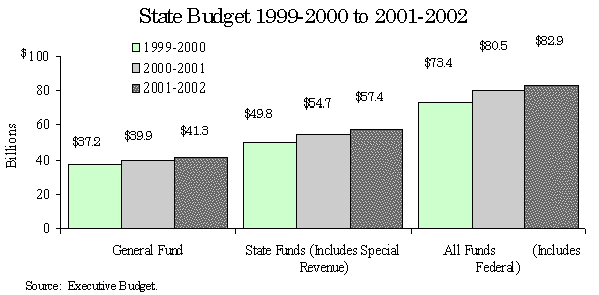
The State also collects a variety of Special Revenue Funds that are dedicated to particular uses. These funds are used to insure that monies are used solely for the purpose for which they are raised, or to insure that individual programs are self-supporting. Examples of such dedicated funding streams include the Environmental Protection Fund and the Dedicated Highway and Bridge Trust Fund. When these funds and non-federal capital and debt service funds are combined with the General Fund, the total is known as State Funds.
The State also receives significant budget support from the Federal government,
which are reported as Federal Funds. State Funds plus Federal Funds combine
to produce an All Funds figure. The All Funds amount is the figure that is usually
reported as the State Budget total.
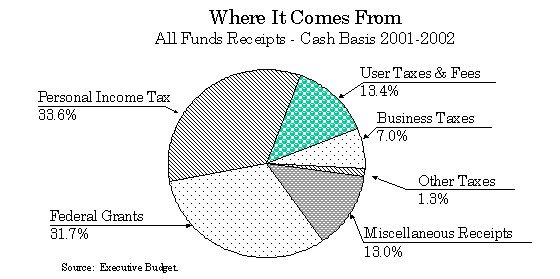
Figure 13
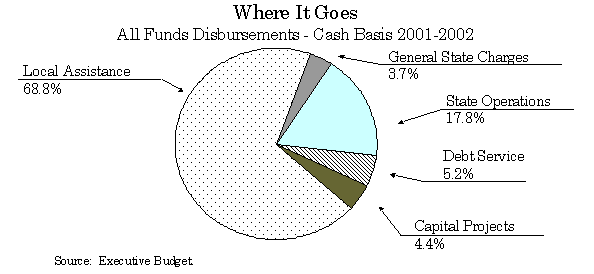
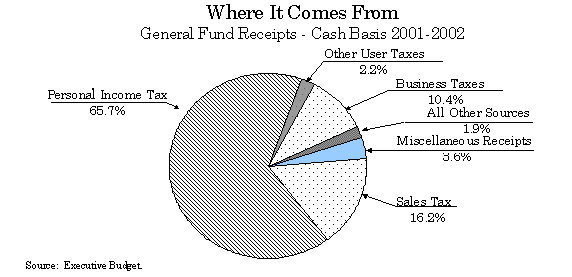
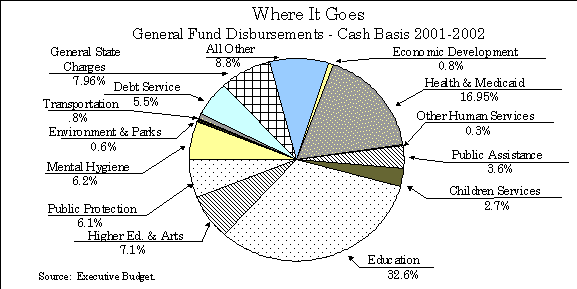
Disbursements
General Fund
The Executive proposes General Fund disbursements for State Fiscal Year (SFY) 2001-02 of $41.3 billion, an increase of $1.447 billion or 3.6 percent over SFY 2000-01.
General Fund disbursements for Health and Social Welfare programs are projected to increase by $298 million, or 3.2 percent, over SFY 2000-2001. Medicaid disbursements are projected to increase by $391 million or 6.9 percent, while public assistance disbursements are expected to decrease by $245 million, which is a 19.5 percent decrease. Mental Hygiene funding disbursements are expected to increase by $211 million or 9.0 percent, and Education disbursements, which include support for Higher Education and elementary-secondary education, are projected to increase by $804 million or 5.2 percent. The proposed education disbursement increase is primarily due to the remaining State fiscal year obligations of the record $1.094 billion school year increase in General Support for Public Schools enacted in School Year 2000-01. For School Year 2001-02, the Executive proposes a $382 million increase, or 2.79 percent.
Public Protection spending is projected to decrease by $55 million or 2.1 percent and Environmental funding is anticipated to increase by $17 million or 7.5 percent. General Fund support for Transportation is expected to decline by $194 million or 38.0 percent. This reduction represents a shift of $169 million of the Snow and Ice Program in the Operations and Passenger and Freight Transportation Program from the General Fund to the Dedicated Highway and Bridge Trust Fund in the Capital Program to increase coverage for the Dedicated Highway and Bridge Trust Fund bonds.
State Funds
State Funds include the General Fund, Special Revenue Funds (other than Federal Funds), Debt Service Funds, and Capital Project Funds. The Executive proposes that in SFY 2001-02, State Funds disbursements increase by $2.684 billion for a total of $57.39 billion. This represents an increase of 4.9 percent over SFY 2000-01.
State Funds support for Health and Social Welfare is projected to increase by $213 million or 1.8 percent. Mental Hygiene disbursements are anticipated to increase by $301 million or 11.7 percent while support for Education is anticipated to increase by $1.045 billion or 5.3 percent. Again, the education disbursement increase is due to prior year obligations, plus the remaining $129 million commitment for the RESCUE Program. STAR Property Tax Relief program disbursements are projected to increase by $694 million or 37.0 percent. Public Protection funding is anticipated to decrease by 82 million or 2.8 percent and State Funds disbursements for Parks and the Environment are projected to increase by $133 million or 15.8 percent. State Funds support for Transportation is anticipated to increase by $164 million or 4.6 percent.
All Funds
The All Governmental Funds basis of disbursement includes All State Funds plus any Federal Funds received by the State. SFY 2001-02 disbursements on an All Governmental Funds basis are projected to be $83.621 billion, an increase of $4.192 billion or 5.3 percent over SFY 2000-01.
All Funds disbursements for Health and Social Welfare are projected to increase by $1.535 billion or 5.1 percent, greater than the rate of State Funds spending noted above. Of this amount, $1.173 billion is related to increased Medicaid disbursements, a 5.9 percent increase. All Funds support for public assistance are projected to increase by $115 million or 4.9 percent.
|
Actual SFY 1999-2000 |
Estimated SFY 2000-2001 |
Change From 1999-2000 |
Proposed SFY 2001-2002 |
Change From 2000-2001 |
|
| General Fund | $37.170 | $39.895 | 7.3% | $41.343 | 3.6% |
| State Funds | $49.796 | $54.707 | 9.9% | $57.390 | 4.9% |
| Federal Funds | $23.470 | $24.723 | 5.3% | $26.231 | 6.1% |
| All Funds | $73.266 | $79.430 | 7.8% | $83.621 | 5.3% |
PROPOSED GENERAL FUND RESERVES AND USES OF THE SURPLUS
In the Midyear Report released in October of 2000, the Executive projected that the State would end State Fiscal Year (SFY) 2000-01 with a $1.085 billion surplus in the General Fund, made up entirely of statutory reserves. The Governor has revised this estimate upwards in the Executive Budget by $59 million for a projected General Fund closing balance of $1.144 billion, again made up entirely of statutory reserves, including $29 million in the Universal Pre-Kindergarten Fund, established in SFY 2000-01. The Executive does not include $2.729 billion in additional funds in the closing balance for 2000-01. Of these funds, $1.2 billion was set aside in SFY 2000-01 for STAR refunds, $250 million was set aside for the Debt Reduction Reserve Fund (moved from the General Fund to Debt Service Fund), and an additional $1.279 billion is proposed to be used in 2001-02 for the Executive's proposed Fiscal Responsibility Reserve. If these funds were taken into consideration, the closing balance would have been $3.87 billion. Total available funds would have been $4.4 billion if not for the use of $500 million to accelerate the payment of Personal Income Tax refunds.
The Governor estimates the SFY 2001-02 General Fund closing balance to be $2.258 billion, allocated as follows: $979 million in statutory reserves, including an $80 million increase in the Tax Stabilization Reserve Fund (rainy day), and $1.279 billion in additional Funds for future negative impact relating to possible economic slowdown.
In addition to the Fiscal Responsibility Reserve Fund, the Executive proposes legislation to increase the maximum allowable size of the Tax Stabilization Reserve (rainy day) Fund from two percent to five percent of the total disbursements from the General Fund.
The State Funds closing balance more accurately reflects funds available for future needs. The Executive's projected closing balance for State Funds for SFY 2001-02 is $2.868 billion.
PROPOSED RESERVES AND USE OF SURPLUS
($ in millions)
| SFY 2000-2001 | SFY 2001-2002 | |||
|
Closing Fund Balance Tax Stabilization Reserve Fund Contingency Reserve Fund Community Projects Fund Universal Pre-Kindergarten Fund Fiscal Responsibility Reserve |
627 150 338 29 0 |
627 150 188 14 1,279 |
||
|
SUB-TOTAL (closing balance) |
1,144 | 2,258 | ||
|
Other STAR Debt Reduction Reserve Fund Additional Surplus |
1,200 250 1,279 | SFY 2001-2002 |
SUB-TOTAL |
2,729 | 2,258 | TOTAL | *3,873 | 2,258 |
Out-Year Impact of the Executive Budget
The Executive's proposed Financial Plan projects an out-year General Fund gap of $2.49 billion in SFY 2002-03 and $2.923 billion in SFY 2003-04, and projects out-year spending to grow at a rate of six percent in SFY 2002-03 and 3.4 percent in SFY 2003-04. The Executive attributes the large growth in SFY 2002-03 to increased spending in education and Medicaid. In the past, the Executive has overestimated out-year gaps by as much as $2.4 billion. For instance, in his SFY 1999-2000 proposal, a General Fund gap of approximately $2.2 billion was projected for SFY 2000-01 (not including use of reserves). The year ended with a positive balance of $227 million (receipts less disbursements), reflecting a $2.4 billion difference. Although disbursements were approximately $1.7 billion higher than projected, receipts were $4.1 billion higher than initial projections.
Capital Program and Financing Plan
The Executive's proposed Capital Program and Financing Plan increases the State funds pay-as-you-go share of capital spending from 25 percent in SFY 2000-01 to 32 percent in SFY 2001-02. The Public Authority debt share of capital spending is reduced to 33 percent, from 37 percent in SFY 2000-01 and reliance on Federal Funds for capital spending is reduced from 32 percent to 29 percent. General Obligation debt is projected to finance six percent of the total capital spending in SFY 2001-02, maintaining the SFY 2000-01 level.
The Capital Plan recommends $4.97 billion capital spending in SFY 2001-02, an increase of 14.4 percent or $627 million over SFY 2000-01. Transportation spending accounts for $2.9 billion of the proposed capital spending for SFY 2001-02. The remaining capital spending projection includes $822 million for Environment and Recreation, $426 million for Education, $203 million for Public Protection, $184 million for Mental Hygiene, $284 million for Housing and Economic Development, and $128 million for all other categories of capital projects.
For SFY 2000-01, an additional deposit of $250 million was made to the Debt Reduction Reserve Fund (DRRF), bringing the total balance to $750 million.
During SFY 2000-01, $500 million from the DRRF was used to pay down $421 million of the State's high cost debt and to provide $79 million for increased pay-as-you-go financing of $21.5 million for Community Enhancement Facility Program (CEFAP) projects and $50 million for the Buffalo Inner Harbor project.
The Executive plans to use the remaining $250 million in DRRF to provide increased pay-as-you-go financing to accelerate certain transportation projects in SFY 2001-02.
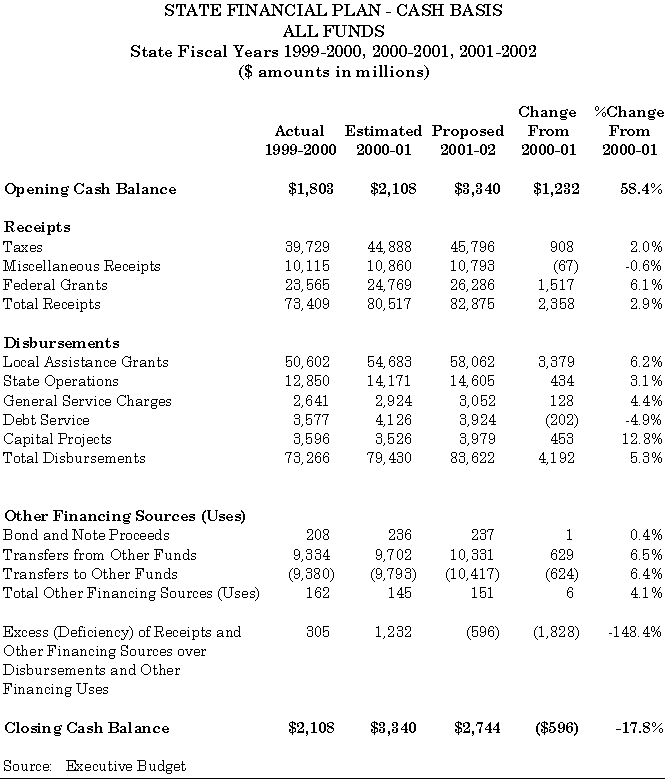
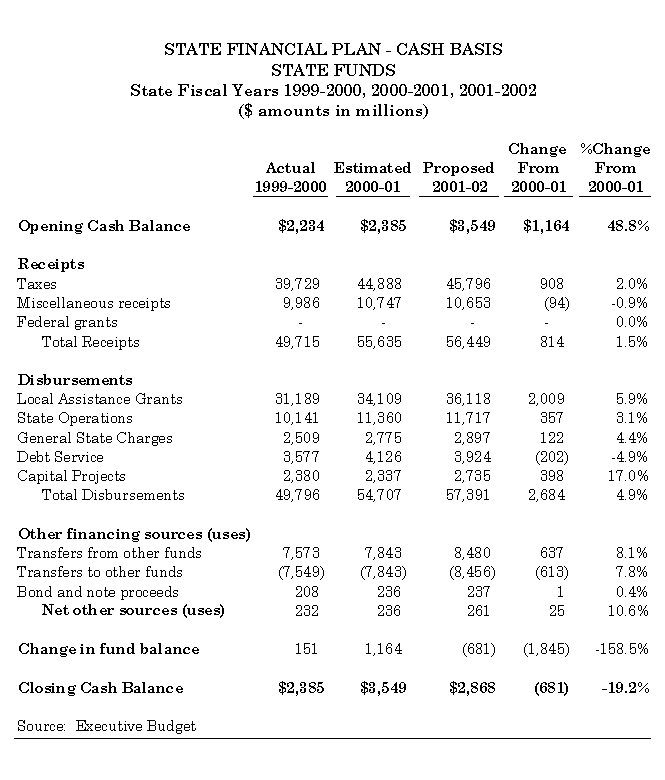
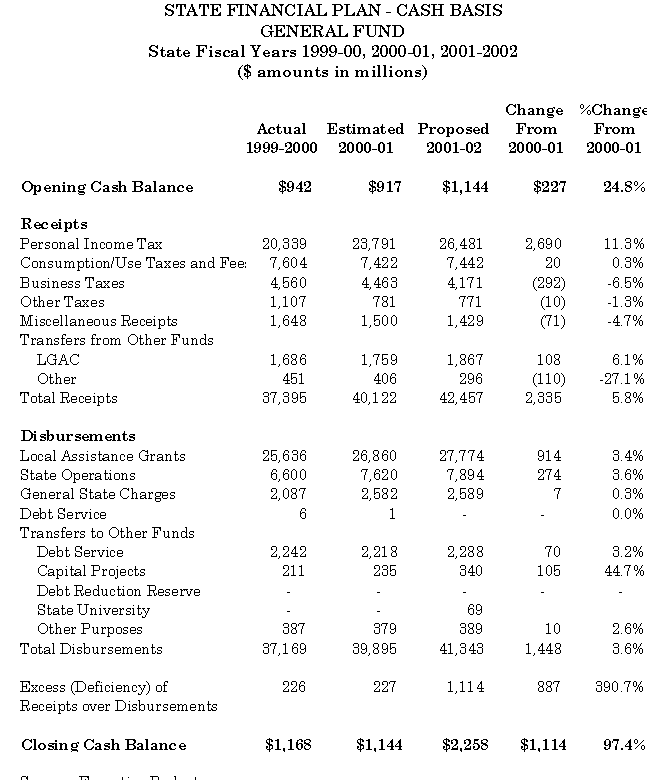
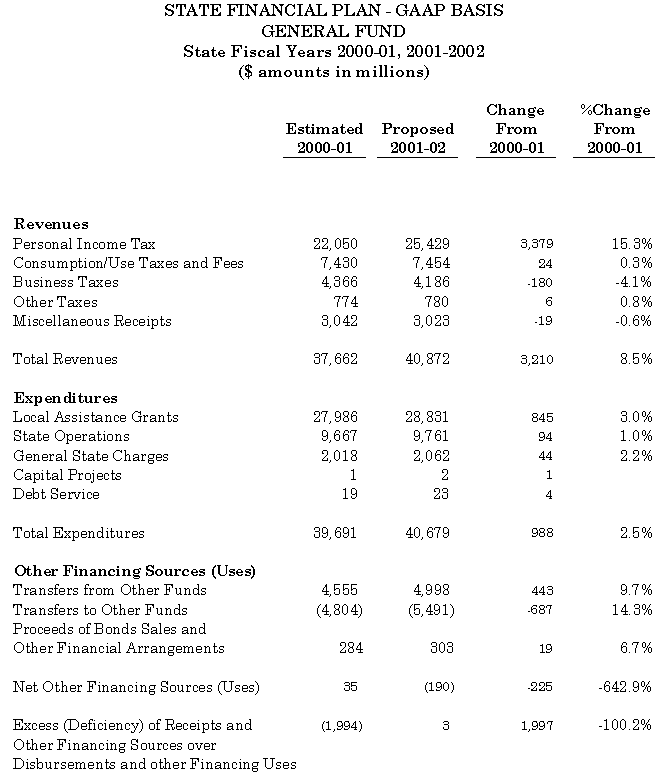
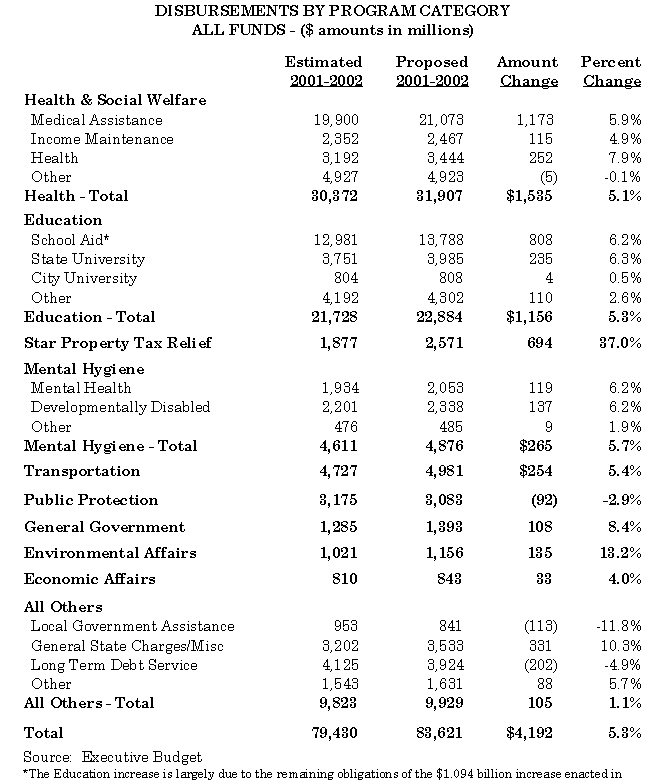
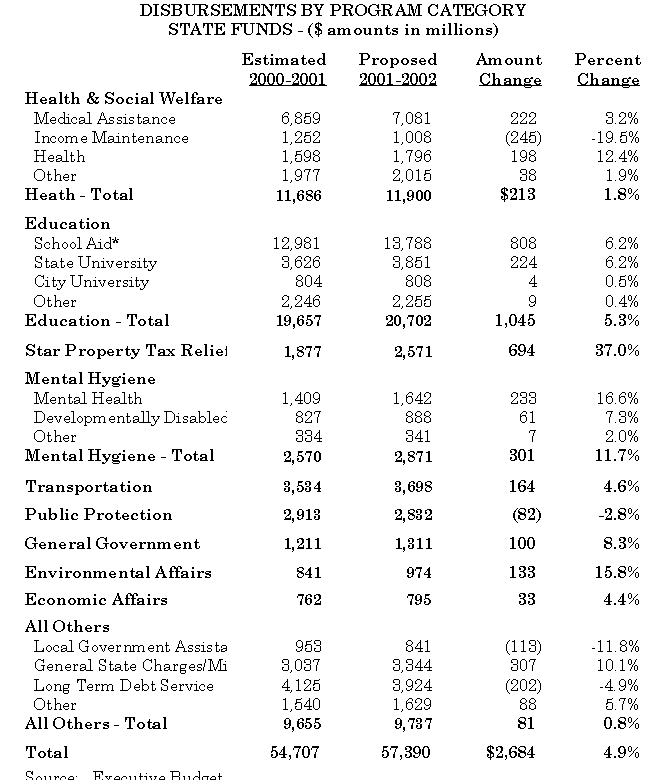
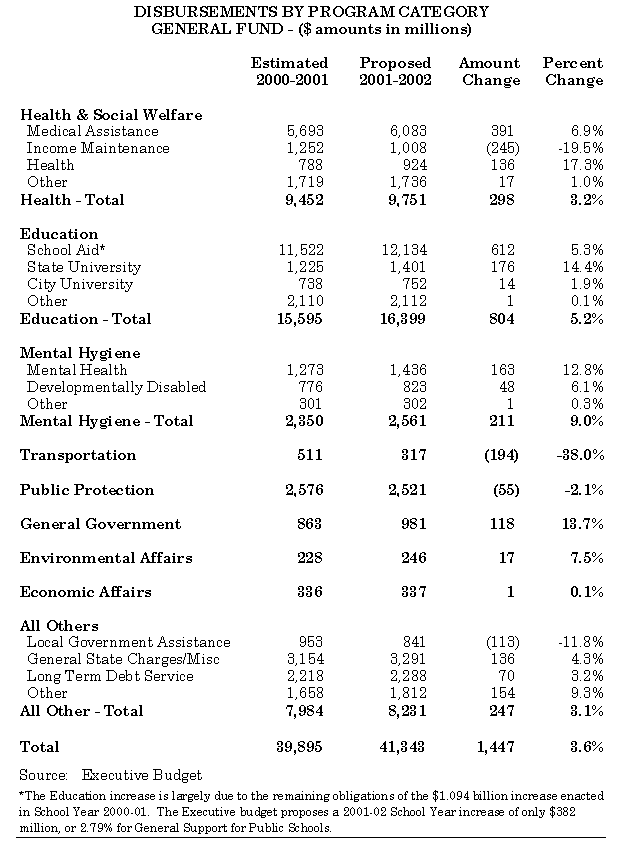
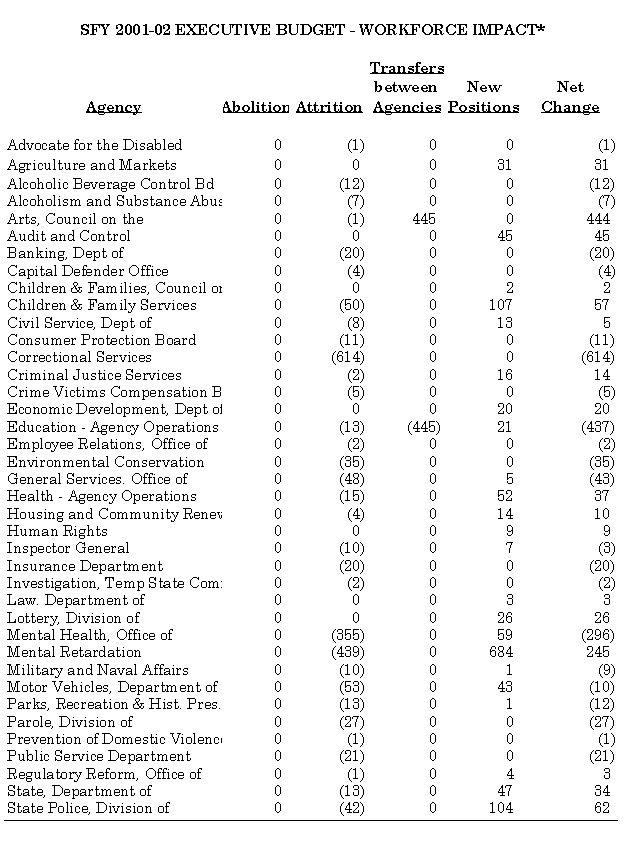
| APPROPRIATION BUDGET BILLS | |
|
A. 1300/S. 900 A. 1301/S. 901 A. 1302/S. 902 A. 1303/S. 903 A. 1304/S. 904 A. 1305/S. 905
|
Legislature and Judiciary Debt Service Public Protection and General Government Transportation and Economic Development Health, Mental Hygiene and Environmental Conservation Education, Labor and Family Assistance
|
NON-APPROPRIATION BUDGET BILLS
A. 1999/S. 1147 Public Protection and General Government
A. 1997/S. 1145 Education, Labor and Family Assistance
A. 2001/S. 1149 Revenue
|
PUBLIC HEARINGS ON THE EXECUTIVE BUDGET FOR STATE FISCAL YEAR 2001-02 |
|||
| DATE | LOCATION | TIME | TOPIC |
| January 22 | Hamilton Room | 10:30 a.m. | Local Government Officials and General Government |
| January 23 | Hamilton Room | 10:00 a.m. | Transportation |
| January 24 | Hamilton Room | 10:00 a.m. | Mental Hygiene |
| January 29 |
Hamilton Room Hamilton Room |
10:00 a.m. 1:00 p.m. |
Workforce Issues Housing |
| January 30 | Hamilton Room | 10:00 a.m. | Elementary & Secondary Education |
| January 31 | Hamilton Room | 10:00 a.m. | Higher Education |
| February 5 | Hamilton Room | 10:30 a.m. | Public Protection |
| February 6 | Hamilton Room | 10:00 a.m. | Human Services |
| February 7 | Hamilton Room | 10:00 a.m. | Environmental Conservation |
| February 12 | Hamilton Room | 10:30 a.m. | Health, Medicaid & Aging |
| February 13 | Hamilton Room | 10:00 a.m. | Economic Development & Taxes |
| FORECAST OF RECEIPTS | |
| On or before February 28 | Release of economic and revenue forecasts by the Fiscal Committees of the Legislature |
All Hearings will be held in the Legislative Office Building, Albany.
__________________________
Note: This Statistical and Narrative Summary analyzes all of the budget bills submitted by the Governor, both multiple appropriation bills and the non-appropriation bills. Many provisions within the submitted appropriation bills would amend or circumvent existing state law. There is a substantial body of case law concerning the unconstitutionality of the inclusion of such provisions in multiple appropriation bills. Our analysis of such provisions without specific and repeated comment as to their constitutionality does not indicate acquiescence by the Ways and Means Committee or the Assembly that such provisions or the submission itself is constitutional.